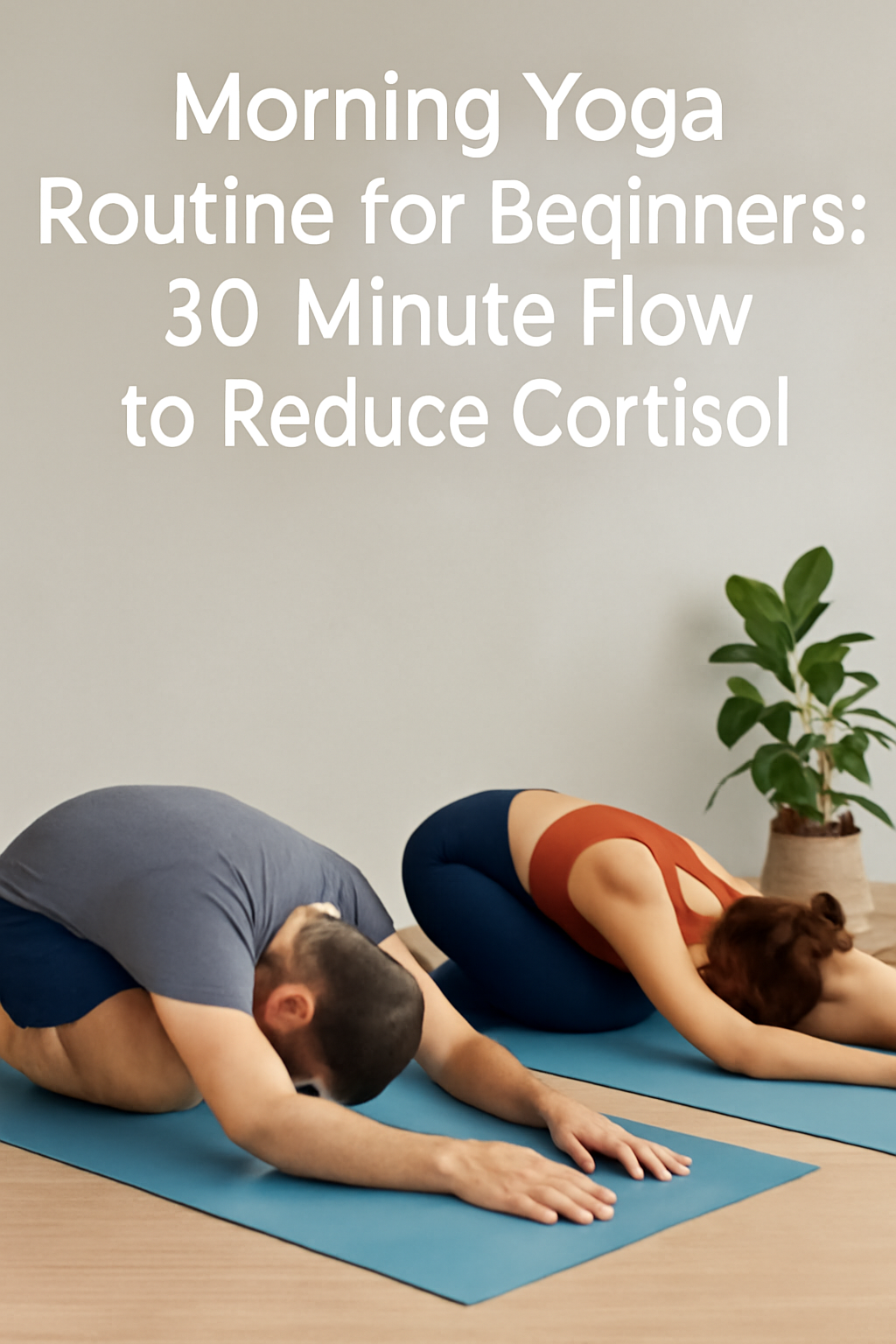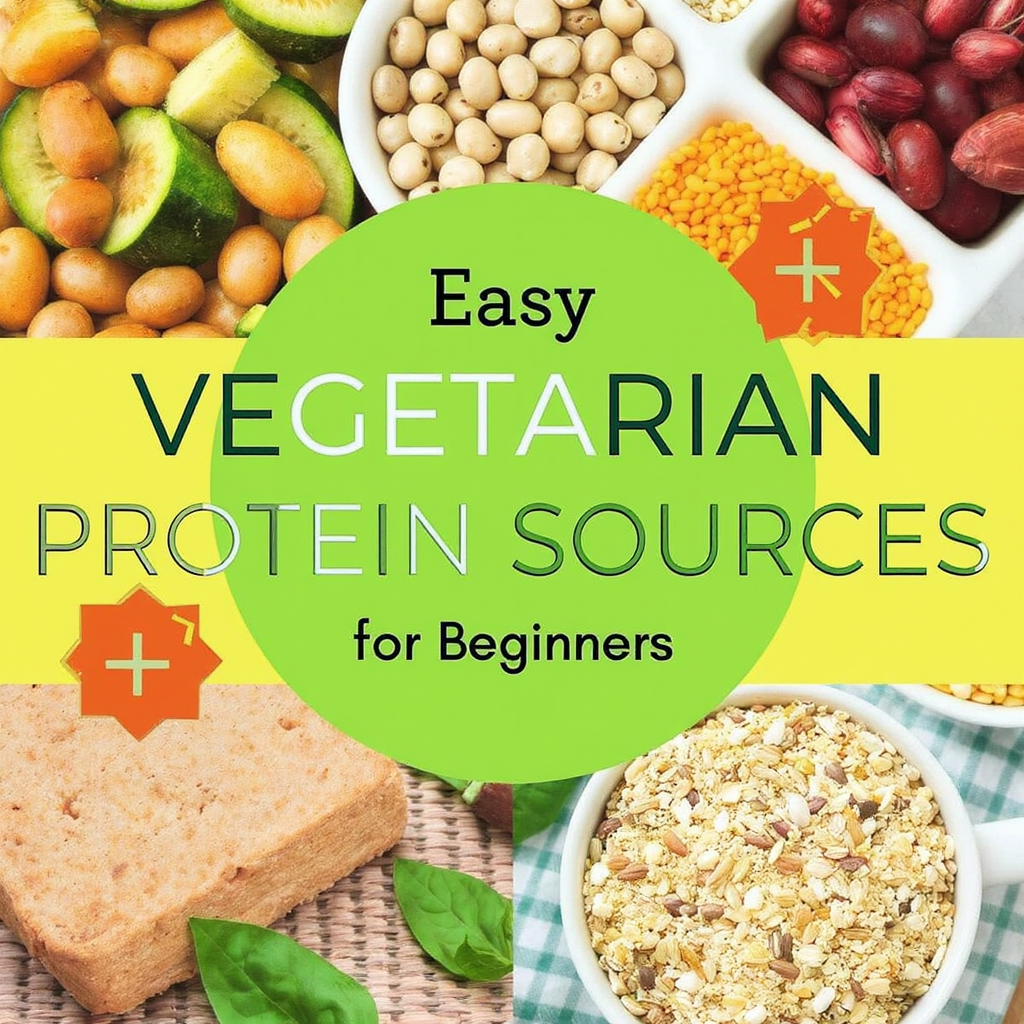Disease Prevention & Health Tips
How to Preventing Cardiac Arrest: Symptoms, Risks and Essential Tips for a Healthy Heart
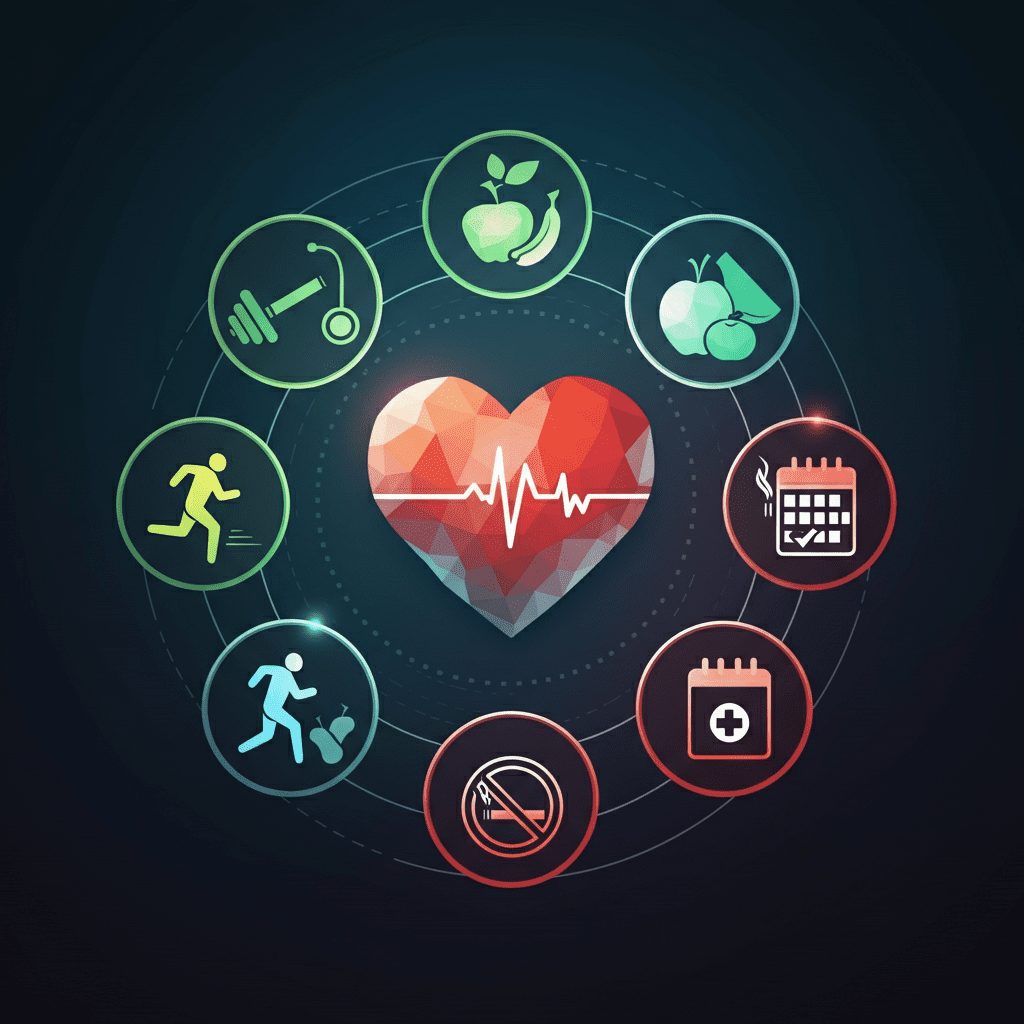
Table of Contents
Cardiac arrest is a severe condition that causes sudden and dangerous events to the health of a person, and it has to be treated. As opposed to a heart attack, the cardiac arrest is an electrical problem within the heart that makes it to come to a halt as it normally does. This dangerous condition can befall any person and there are means of minimizing the chances. This guide will comprise practical prevention tips, including lifestyle, medical, and knowledge about the main risk factors.
The heart conditions are closely connected to cardiac arrest and cardiac arrest is closely associated with the underlying diseases as well as health conditions. Diseases like coronary artery diseases, arrhythmias or cardiomyopathies may cause the risk of sudden cardiac arrest to be raised significantly. It is through identification of these risk factors that proactive prevention should be made with prior focus being put in maintaining a good heart health and being aware of the warning signs to curb them at an early stage before they degenerate into life threatening situations.
Understanding About the Cardiac Arrest
Cardiac arrest happens when there is a failure to maintain the heart and it becomes unable to pump blood through the human body because of the failure in the electrical system of the heart. It causes the loss of consciousness in a second and needs emergency treatment. It is not that of a heart attack when the flow of blood into the heart is blocked but the heart might still be pumping.
Early Warning Signs of Cardiac Risk
- There are warning signs, which imply cardiac arrest risk. These include:
- -Heartburn or chest discomfort or pain
- -Difficulty of breathing
- -Unusual heart beating (palpitations)
- -Light minor or fainting
- -Unexplained fatigue
- Being able to identify these symptoms and consult a doctor in time can prove to be a difference.
Key Risk Factors
Knowing the causes of cardiac arrest will be important towards knowing measures that can be taken to prevent it. Risk factors are of two major categories i.e. modifiable and non-modifiable.
Non-Modifiable Risk Factors
Age: This risk clinically relates to age and especially among individuals above 50 years. Gender: Men tend to be more at risk category than women except women become more at risk after menopause. Genetics: Family history is a major contributing factor and particularly when there are inherited diseases of the heart such as hypertrophic cardiomyopathy.
Modifiable Risk Factors
Smoking: Smoking destroys the blood vessels hence creates a tendency to contract heart condition. Unhealthy Diet: Unbalanced diets which include much of saturated fats, sugar, and processed foods are also a contributing factor to obesity as well as cholesterol. American Diet: No physical activities make the heart to become weak. Stress: The body responds to stress by causing changes in the hormonal level and in effect, this can cause heart problems.
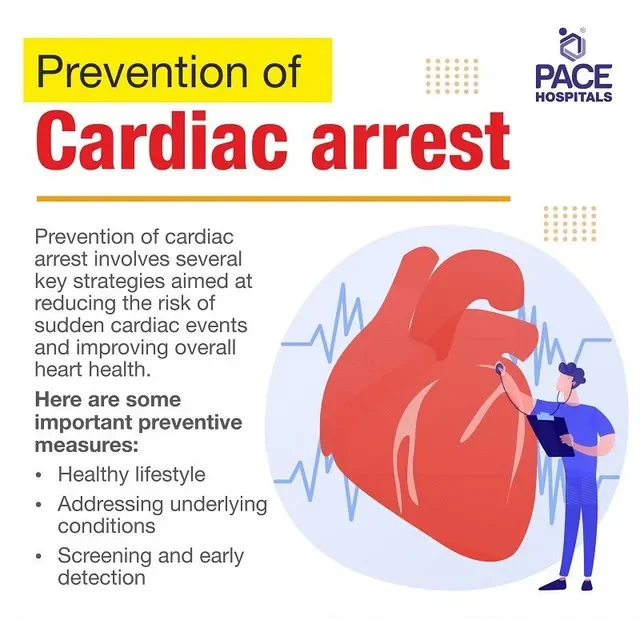
Prevention Strategies
Life can be saved by taking a proactive approach to the risks. All prevention strategies include the change of lifestyle or introduction of medical interventions, all of which are evidence-based.
1. Healthy Lifestyle & Exercise Regularly
One of the best methods of reinforcing the wellness of the heart and reducing cardiac arrest is undertaking a regular exercise. According to cardiologists and the major health organizations, a minimum of 150 minutes of easy-to- moderate exercise per week should be done, and a brisk walk, bicycling, or swimming is a good idea. Exercise can also increase cardiovascular performance and is an effective way of blood pressure regulation, reducing bad cholesterol, and maintaining a healthy weight and all of this is vital in the prevention of heart attacks and general cardiovascular disease.
When you maintain a regular schedule of physical activities, you decrease the risk of occurring heart incidents dramatically and enhance the flow of healthy blood in every part of your body. Physical activity also reduces stress levels and improves sleep which has a connection to the heart. It is my reminder that before any individual exercises any new exercise routine, it is preferable to meet with your healthcare provider to get customized suggestions.
2. Eat a Heart-Healthy Diet
The use of a heart-healthy diet is among the most effective measures of preventing cardiac arrests and ensuring long-term cardiovascular wellbeing. The risk of having a heart attack and stroke can be minimized significantly by means of a nutrition plan that is focused on lots of fresh vegetables, fruits, whole grains, and lean proteins. Make it a point to include the healthy super-foods like salmon, walnuts, berries, and leafy vegetables all that contain the necessary omega-3 fatty acids, anti-oxidants and fiber. Parked and refined foods, as well as saturated fats, added sugar and excess salt should also be avoided because they can increase blood pressure and cholesterol.
You can further be heart-friendly by using healthy fats like olive oil and avocado as well as by cutting down portion sizes of meat (red meat). Despite the increased energy and weight management advantages that such evidence-based nutritional guidelines bring, they also ensure improved functionality of the heart and lower chances of contracting cardiovascular diseases. It is important to keep in mind that good nutrition is one of the most important steps in the process of the full-fledged prevention of cardiac arrest.
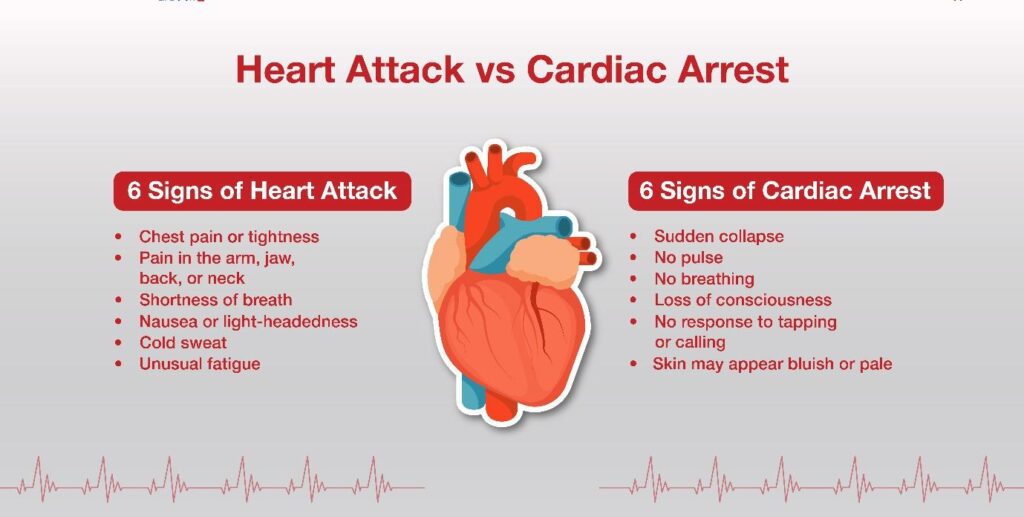
3. Quit Smoking
The number of things that you can do to improve your heart health and health in general in the long term includes quitting smoking. Smoking is one of the conditioning causes of cardiac arrest, coronary artery disease, and stroke including several other cardiovascular diseases. After you have stopped smoking, your blood pressure and pulse rate get to rest and your heart system takes a rest. Your chances of suffering a heart attack or sudden cardiac arrest shrink vastly as time passes by, meaning seven years after you quit, your risk of heart ailment will be approximately half that of a heart smoker.
This change saves life with the help of smoking cessation programs, nicotine replacement therapies and support groups that mitigate this situation and make it more sustainable. By adopting a smoke-free life style you can not only help yourself to become healthier but you will also be freeing other people by preventing them to be exposed to secondhand smoking. Decide now that you will leave smoking and enjoy both short-term and long-term mutual cardiovascular effects and reduce the incidence of cardiac arrest.
4. Maintain a Healthy Weight
One of the best approaches to be able to limit your chances of getting cardiac arrest and other diseases that concern the heart is to be able to achieve and maintain a healthy weight. It may also predispose high blood pressure, high cholesterol and diabetes type 2 which are heart disease risk factors and this disease progresses silently and in addition, being overweight causes heart disease. Even more, relatively small weight loss including even the loss of mere 5-10 percent of your total body weight has been known to greatly reduce the chance of heart attack and sudden cardiac death.
By employing the best weight management strategies, selecting foods with nutrient density, tracking the number of calories consumed, and engaging in physical exercises are important aspects of attaining a healthy weight loss target. Bear in mind, that the correct BMI and a specific waist measurement are useful indicators of good cardiovascular health, and lifetime success in weight control can transform the quality of life and life expectancy to an enormous extent. Ask a healthcare expert to formulate an individualized but long-term plan of achieving and sustaining your heart-healthy weight.
5. Stress Management Techniques
Persistent stress is one of the causes of blood pressure and other cardiac related risks. Some stress management techniques are:
-Mind and Meditation practices -Deep breathing technique -Such physical exercises as yoga -Communal involvement and good support networks
6. Monitor and Manage Medical Conditions
Cardiac risk is increased by conditions such as diabetes, high cholesterol and hypertension. These can be managed with regular check-ups, medications and constant monitoring.
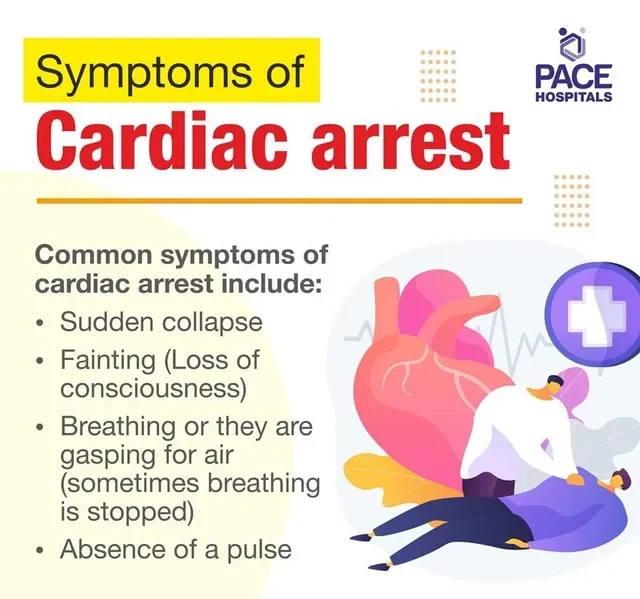
Medical Interventions
Cardiac risks can be dealt with by several measures through medical knowledge and advancements.
Preventive Medications
- Daily Aspirin (as prescribed) can reduce blood clot risks.
- Statins help lower bad cholesterol and prevent arterial blockages.
Regular Health Screening
Routine health evaluations, including blood pressure checks, cholesterol tests, and heart imaging scans, can detect problems early.
Devices and Procedures
- Implantable Cardioverter Defibrillators (ICDs) are small, battery-powered devices that can correct arrhythmias and potentially prevent cardiac arrest.
- Coronary Angioplasty and Bypass Surgery may be recommended in severe cases to improve blood flow.
Lifestyle Modifications
The effect of behavioral change is long-term with respect to heart health. These are changes in meals, exercise and lifestyle.
A Heart-Healthy Meal Plan
Focus on the Mediterranean Diet—rich in olive oil, nuts, whole grains, and lean protein. Reduce sodium by cooking at home and avoiding processed foods.
Prioritize Sleep
Lack of sleep contributes to high blood pressure and stress, increasing cardiac arrest risks. Aim for 7-8 hours of quality sleep each night.
Stay Physically Active
Even small changes, like using stairs instead of elevators or incorporating short walks into your day, can positively influence heart health.
Alcohol in Moderation
Excessive alcohol consumption strains the heart. Stick to the recommended limit of one drink per day for women and two for men.
People also ask(FAQs)
1. Which Exercises are Heart Disease Preventive?
Ans: Exercises such as running, cycling, swimming are the best cardio. Flexibility and strength training are also cardiovascularly strengthening.
2. What are the effects of diet on the heart?
Ans: The balanced diet reduces obesity, guards against arterial sclerosis and lowers the cholesterol levels. Important is to add foods with high content of omega-3 fats and minimize trans fats.
3. Does Stress lead to Cardiac Arrest?
Ans: Yes, arrhythmia may be provoked by strong emotional or physical stress. It is essential to prevent stress levels.
4. When Do I need Heart Check-ups?
Ans: People age 40 or people with risk factors are to speak with a physician on a yearly basis. The young adults are to be concerned with periodic screenings basing on medical recommendations.
Conclusion
The first step to avoiding cardiac arrest is education and prevention decisions. You can decrease your risks of getting a cardiac arrest drastically by learning about risks, making your lifestyle healthier and coming to use medical resources. Start today, by having a heart health check-up and making a small lifestyle changes that may make a life time difference. You can now begin to protect your heart because the power is in your hands! Finally, preventive measures such as being informed about heart health, risk factor management and positive behavioral modification should form a complete part of heart health investment strategies. Routine visit, proper diet, exercise, and the lack of unhealthy lifestyles, such as smoking, are all the factors that make you less susceptible to the cardiovascular disease and the risk of sudden cardiac arrest.
The question of health about the heart is an issue of concern throughout life when one is equipped with the means of recognizing symptoms and early warning signs, as well as the ability to take charge of the process. By remaining self-proactive and informing others about this information, you will help to build a better and a healthier world and future in terms of safety not only of your own, but also of society.
Any apt Disclosure To Be Clear
This guide is of informational nature only. Never go against the professional opinion of your healthcare provider by developing your own diagnosis and course of action that would govern your individual health conditions.
M. Saim Akhtar
Certified Health Content Specialist at HealthBoostMax. INFS-qualified nutrition researcher with 5+ years of evidence-based health writing. Focus areas: health wellness information, preventive medicine, nutritional biochemistry, and fitness science. Content is for informational purposes only!
Healthy Lifestyle & Nutrition
7-Day High Cholesterol Diet Plan (Dietitian-Approved in 2025)

Table of Contents
Managing high cholesterol is key to maintaining heart health and reducing the risk of serious diseases like heart attacks or strokes. A diet plan plays a pivotal role in this process. By incorporating cholesterol-lowering foods like soluble fiber, omega-3 fatty acids, and unsaturated fats, you can make meaningful strides toward a healthier lifestyle. These nutrients not only improve cholesterol levels but also enhance overall heart health.
However, it’s important to remember that dietary changes complement, not replace, medical advice. This 7-day cholesterol-lowering meal plan is designed for general guidance and should be customized to suit individual health needs. Always consult your doctor or dietitian to ensure this plan works for you.
Core Principles (Dietitian-Recommended)
Soluble Fiber is Essential
Soluble fiber binds to cholesterol in your digestive system, helping reduce the amount that enters your bloodstream. Foods rich in soluble fiber include oats, apples, kidney beans, and oranges. Incorporating these into your meals can significantly improve your cholesterol levels.

Add Healthy Fats
Replace saturated fats with unsaturated fats to improve your cholesterol profile. Include walnuts, flaxseeds, olive oil, and fatty fish (like salmon) in your diet. These sources are also rich in omega-3 fatty acids, which help lower triglycerides and support heart health.
Avoid Processed Foods
Processed foods, such as red meats, fried snacks, or packaged goods, may contain unhealthy trans fats that increase bad cholesterol (LDL) levels. Opt for fresh, whole foods instead.
By focusing on these three principles, you’ll build a solid dietary foundation to manage high cholesterol effectively.
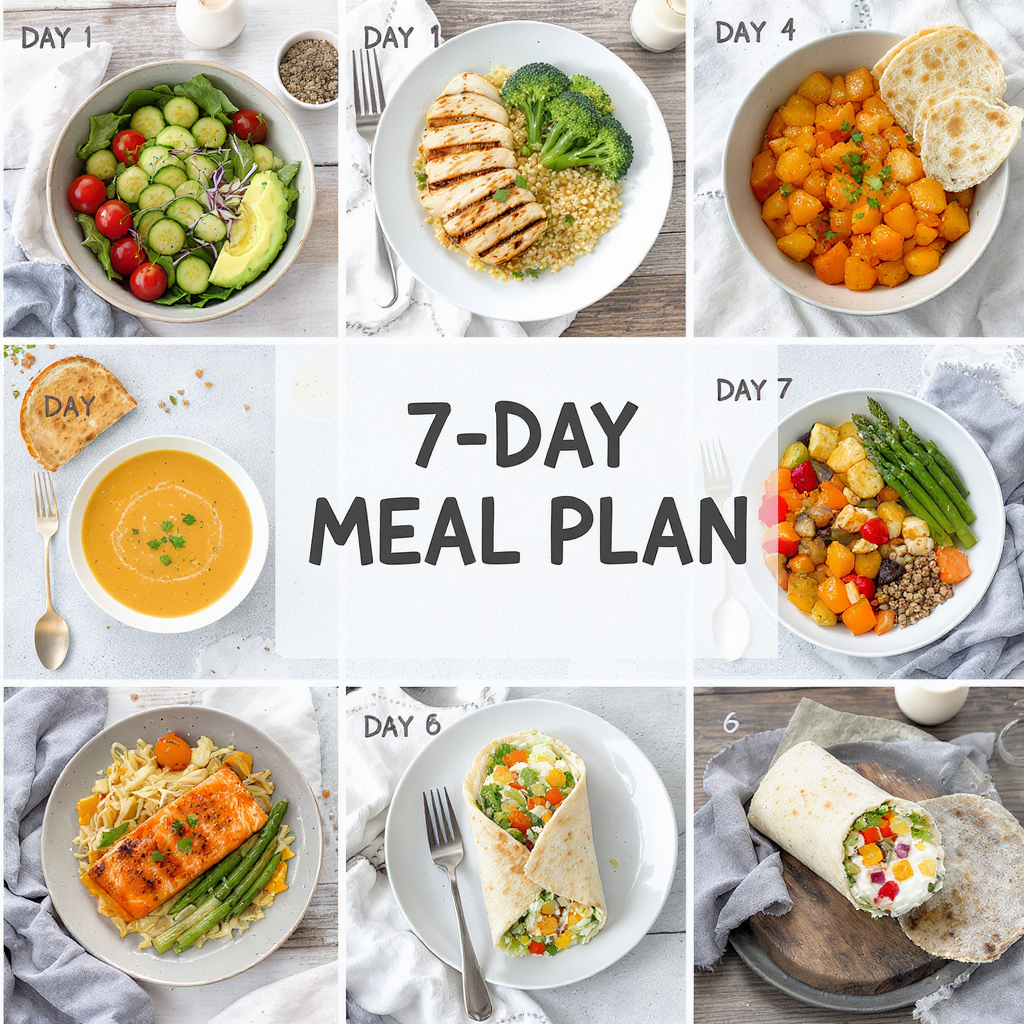
7-Day Meal Plan
Day 1
Breakfast
- 1 bowl of oatmeal topped with sliced apple and 1 walnut.
- Green tea or black coffee (no sugar).
Lunch
- Kidney bean curry with 1 cup of brown rice.
- A side of cucumber and tomato salad with a squeeze of lemon.
Dinner
- Moong dal cheela (lentil pancakes) served with steamed spinach seasoned lightly with olive oil and garlic.
Day 2
Breakfast – Greek yogurt with fresh berries, honey, and crushed almonds
Lunch – Whole grain pasta salad with vegetables (such as tomatoes, cucumbers, and bell peppers) and olive oil dressing
Dinner – Black bean and vegetable stir-fry served over brown rice
Day 3:
Breakfast – Avocado toast on whole grain bread topped with poached eggs
Lunch – Lentil soup with whole grain crackers and a side salad
Dinner – Grilled tofu with roasted sweet potatoes and broccoli
Day 4:
Breakfast – Whole grain toast with almond butter and banana slices
Lunch – Quinoa and black bean wrap with spinach, bell peppers, and salsa
Dinner – Turkey meatballs served over whole wheat spaghetti with tomato sauce
Day 5:
Breakfast – Overnight oats with chia seeds, almond milk, and mixed berries
Lunch – Grilled vegetable sandwich on whole grain bread with hummus spread
Dinner – Baked chicken breast with roasted Brussels sprouts and quinoa pilaf
Day 6:
Breakfast – Whole wheat pancakes with fresh fruit and a side of scrambled eggs
Lunch – Greek salad with grilled chicken, whole grain pita bread, and tzatziki sauce
Dinner – Vegetable stir-fry served over brown rice for a flavorful and healthy meal.
Day 7:
Breakfast – Avocado toast on whole grain bread topped with a poached egg and cherry tomatoes
Lunch – Quinoa and kale salad with roasted sweet potatoes, dried cranberries, and balsamic vinaigrette
Dinner – Grilled salmon with lemon garlic butter served with steamed vegetables and quinoa.
Key Notes
Portion Control
Overeating—even healthy foods—can hinder your progress. Stick to these basic guidelines for portion sizes:
- Nuts and seeds: 1 handful per day.
- Cooking oils (healthy oils like olive oil): Use a spray to control quantities.
Customization
- Vegetarian Swaps: Substitute tofu or paneer for meat-based protein.
- If Diabetic: Reduce portions of rice or other high-GI foods and include more fibrous vegetables.
Stay Hydrated
Drink at least 8 glasses of water daily. Consider adding green or peppermint tea for extra health benefits. Staying hydrated also helps your body flush out toxins and supports overall well-being.
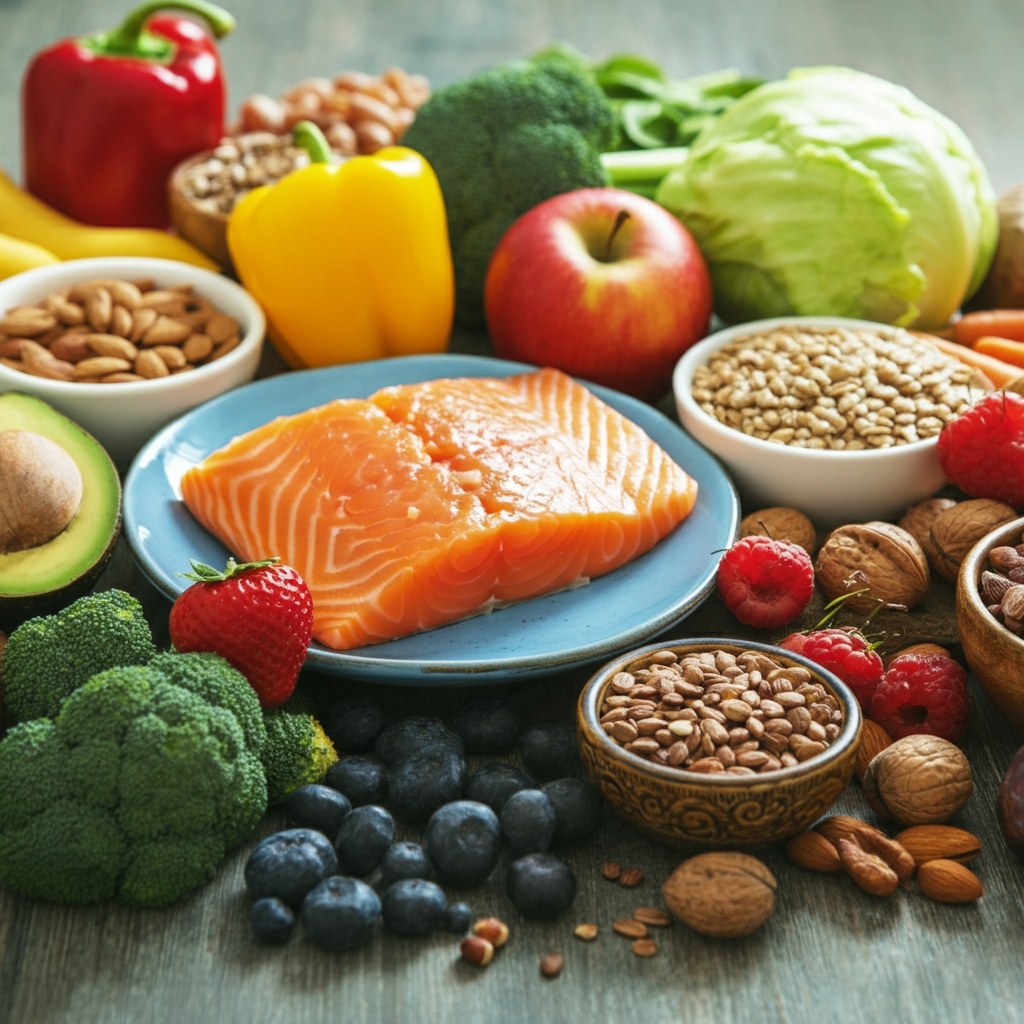
Meal Prep Tips
- Plan Ahead: Create a weekly meal plan to save time and reduce stress. Having a plan minimizes impulsive, unhealthy choices and helps you stick to your goals.
- Batch Cooking: Prepare larger portions and store them in individual containers for easy grab-and-go meals throughout the week.
- Use Fresh Ingredients: Incorporate seasonal fruits and vegetables for optimal flavor and nutritional value.
Mindful Eating
- Eat Slowly: Take the time to chew your food thoroughly, as this aids digestion and allows your brain to register fullness.
- Portion Control: Use smaller plates to trick your brain into feeling satisfied with less food.
- Avoid Distractions: When eating, focus on your meal instead of watching TV or scrolling through your phone, which can lead to overeating.
Success Tips
Label Reading is Crucial
Look for labels that clearly state “zero trans fats” and avoid foods high in added sugars or processed ingredients.
Keep Moving
Physical activity complements a healthy diet. Aim for 150 minutes of moderate exercise, such as brisk walking or cycling, every week.
Manage Stress
Stress indirectly affects cholesterol levels. Practicing yoga, meditation, or even deep breathing for 10 minutes daily can help keep your stress in check.
These small measures, when paired with a heart-healthy diet, can amplify your results over time.
Regular Health Check-Ups
Monitoring your health is essential in managing cholesterol levels effectively. Regular check-ups with your healthcare provider can help detect any issues early and track your progress. Blood tests to measure your LDL (bad cholesterol) and HDL (good cholesterol) levels provide valuable insights into your heart health. Discuss your results with your doctor and work together to adjust your lifestyle or medications if necessary. Taking a proactive approach ensures you’re staying on the right path toward better cardiovascular health.
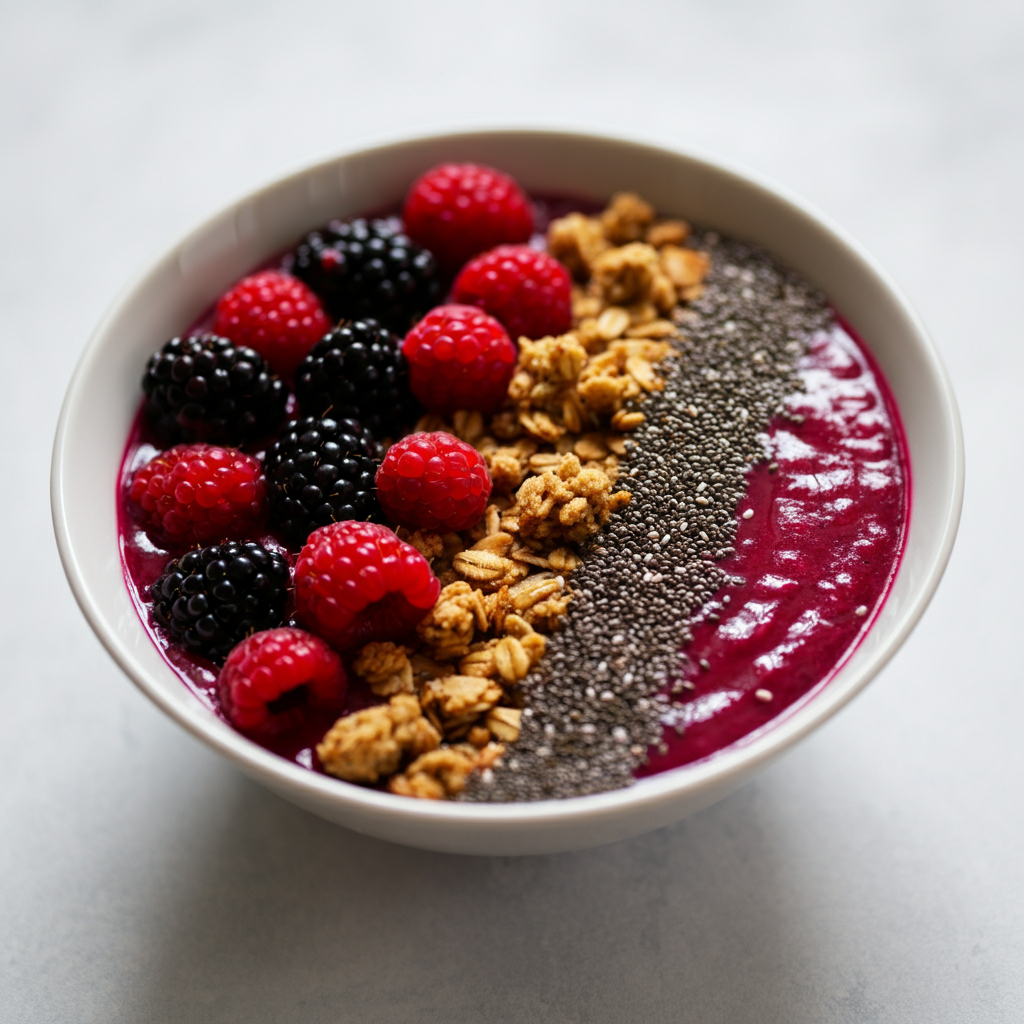
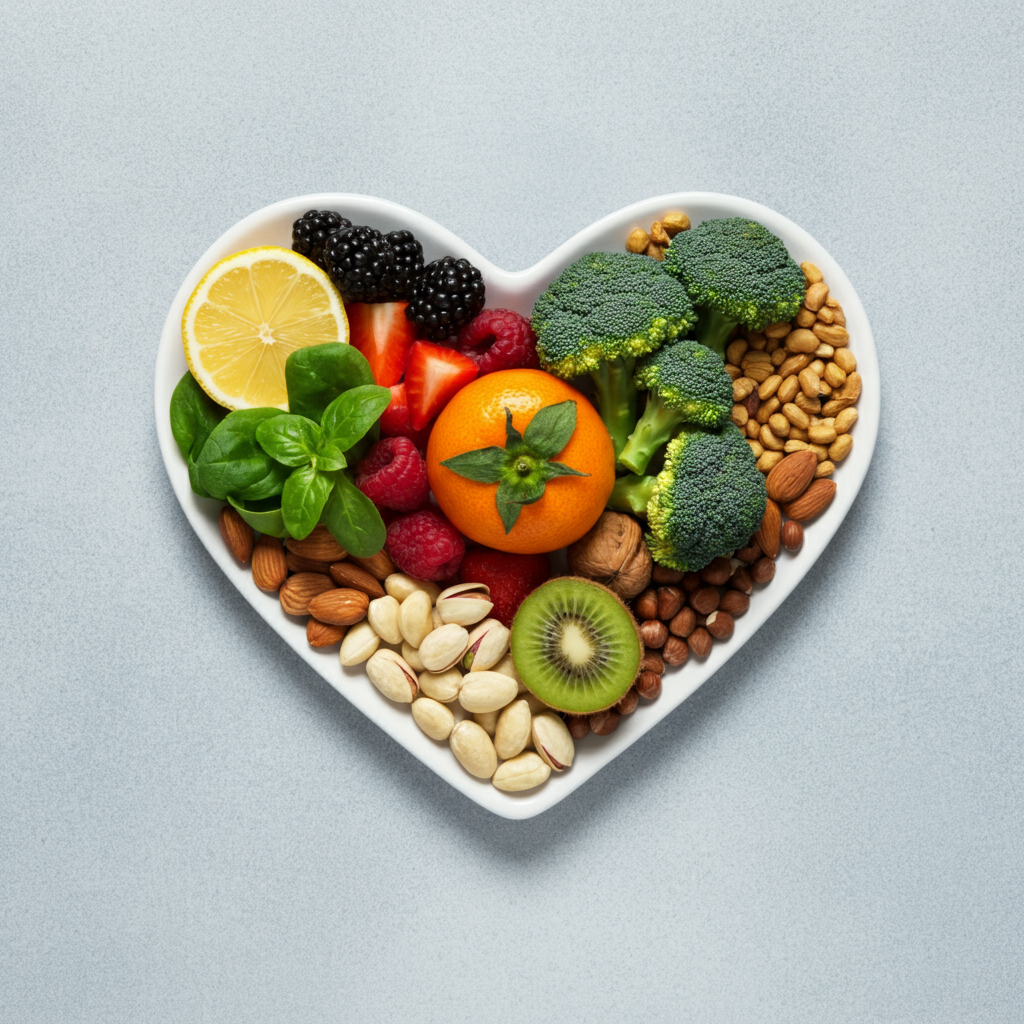
Additionally, incorporating physical activity into your daily routine is essential for maintaining healthy cholesterol levels. Aim for at least 30 minutes of moderate exercise most days of the week, such as brisk walking, jogging, cycling, or swimming. Exercise not only helps raise HDL (good cholesterol) but also assists in lowering LDL (bad cholesterol) and improving overall heart function. Pairing regular activity with a balanced diet rich in fruits, vegetables, whole grains, and lean proteins can amplify these benefits. Remember, small, consistent changes can lead to significant, lasting improvements in your cardiovascular health.
Frequently Asked Questions (FAQs)
Can I eat ghee?
Yes, but moderation is key. Limit ghee (clarified butter) consumption to 1 teaspoon per day.
Should I avoid egg yolks?
Egg yolks can increase cholesterol intake, so it’s best to limit them to 2 per week. Egg whites, however, are a high-protein, cholesterol-free alternative.
Are potatoes bad for cholesterol?
Potatoes themselves are not harmful, but how they are prepared matters. Avoid fried options and choose baked or boiled versions instead.
How often can I eat fish?
Fatty fish like salmon or mackerel can be enjoyed 2-3 times per week for their omega-3 benefits.
Is coconut oil good for cholesterol?
Coconut oil contains saturated fats, which should be consumed sparingly. Stick to heart-healthier oils like olive or avocado oil.
Can I snack between meals?
Yes, but choose healthy snacks like raw nuts, seeds, or a piece of fruit to avoid spiking cholesterol levels with processed foods.
Conclusion
Lowering cholesterol begins with mindful food choices. This dietitian-approved 7-day high cholesterol diet plan outlines nutritious, easy-to-make meals that are not only heart-healthy but also delicious. By focusing on soluble fiber, healthy fats, and portion control, you can achieve meaningful improvements in cholesterol levels and overall health.
Start incorporating small changes today. Take charge of your health and consult with a healthcare professional to tailor this plan to your unique needs. A healthier heart is just one meal plan away! Start your journey to a healthier lifestyle with Health Boost Max.
M. Saim Akhtar
Certified Health Content Specialist at HealthBoostMax. INFS-qualified nutrition researcher with 5+ years of evidence-based health writing. Focus areas: health wellness Information, preventive medicine, nutritional biochemistry, and fitness science.
Men’s & Women’s Health
Best Natural Skincare Routine for Sensitive Skin

Table of Contents
Sensitive skin requires special attention, and the choice of the skincare products which would not provoke irritations may not be easy. Luckily, that is where natural skincare comes to the rescue! Using items right out of your kitchen cupboard, you can have yourself a routine that is smooth, efficient, and absolutely devoid of any harmful chemicals. Honey, a wonderful skin cleanser; Oatmeal, a wondrous soothing exfoliant, and Aloe Vera, a moisturizer that will never block your pores. Depending on what you are fighting, be it acne, premature signs of aging or rosacea, this dermatologist-recommended regime can be adjusted to your skin requirements.
Questioning how you can stabilize your skin’s pH, or wondering whether tap water has an impact on your skin? Find simple natural ways to get good and glowing skin. This guide will take you through a no-nonsense 5 step routine, provide a DIY vitamin C serum recipe, and the benefits of hypoallergenic moisturization and non-comedogenic oils.
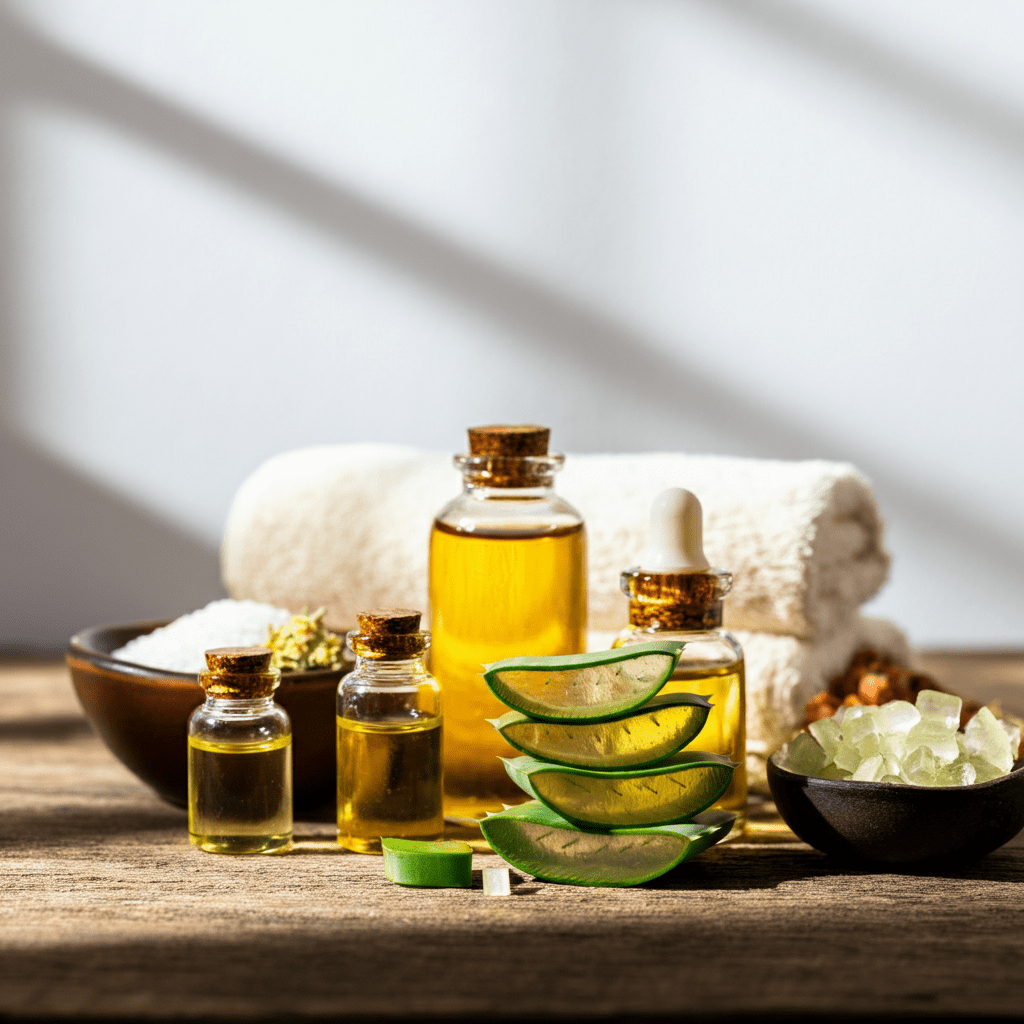
A Dermatologist-Approved 5-Step Routine
Transform your skincare routine using simple, natural ingredients with this effective 5-step guide designed for sensitive skin.
1. Cleanse with Honey
Honey is a natural humectant, drawing moisture to your skin. Its antimicrobial properties make it ideal for sensitive, acne-prone skin.
How to Use:
- Use 1 teaspoon of raw, organic honey.
- Gently massage it onto damp skin in circular motions for 1-2 minutes.
- Rinse off with lukewarm water.
Honey keeps your skin hydrated while cleansing, without stripping natural oils.
2. Exfoliate with Oatmeal
Oatmeal is a soothing, gentle exfoliant that removes dead skin cells and calms irritation.
How to Use:
- Blend 2 tablespoons of oats into a fine powder.
- Mix with a little water or milk until it forms a paste.
- Gently massage onto your skin and rinse with cool water.
This natural exfoliant is especially helpful for those with rosacea or redness.
3. Tone with a DIY pH-Balancing Solution
Using a toner helps maintain your skin’s pH balance. Apple cider vinegar is an excellent natural option.
How to Use:
- Dilute 1 part apple cider vinegar with 2 parts distilled water.
- Apply gently with a cotton pad.
Be cautious with the concentration to avoid irritation; always test patch first.
4. Moisturize skincare with Aloe Vera
Aloe vera gel is perfect for locking in hydration without clogging pores. It’s non-comedogenic and hypoallergenic, making it ideal for sensitive skin.
How to Use:
- Scoop out pure aloe vera gel from the plant or use store-bought, organic options without additives.
- Apply a thin layer after toning.
Aloe also soothes inflammation, making it great for conditions like rosacea and acne.
5. Sun Protection with Mineral Sunscreen
All-natural, mineral-based sunscreens containing zinc oxide or titanium dioxide are less likely to irritate sensitive skin while providing effective sun protection.
How to Use:
- Apply generously as the final step in your morning routine.
Skipping sunscreen can worsen redness and sensitivity, so this step is a must!

Customizing the Routine
Acne-Prone Skin
- Add 2 drops of tea tree oil to your moisturizer for its antibacterial properties.
- Use non-comedogenic oils like jojoba or grapeseed for hydration.
Aging Skin
- Include a DIY vitamin C serum (see the recipe below) to brighten your complexion and reduce fine lines.
Rosacea
- Avoid harsh exfoliants and opt for hydrating oatmeal masks instead.
- Stick to soothing ingredients like cucumber slices or chamomile tea compresses.
DIY Vitamin C Serum Recipe
Vitamin C serums can brighten skin, fade dark spots, and boost collagen production. Here’s how to make your own at home.
Ingredients:
- 1 teaspoon L-ascorbic acid powder
- 1 tablespoon distilled water
- 1 teaspoon aloe vera gel
- 5 drops vitamin E oil (optional for added nourishment)
Instructions:
- Dissolve the L-ascorbic acid in distilled water.
- Mix in aloe vera gel and vitamin E oil.
- Store in a dark glass bottle and use within a week to maintain freshness.
Apply this serum at night before your moisturizer for glowing and healthy skin.

pH-Balancing Tips and Tap Water Dangers
Why pH Matters: Your skin’s natural pH is slightly acidic, around 5.5. When products or water throw this balance off, it can lead to irritation, dryness, and breakouts.
Tap Water Tip: The pH of tap water typically ranges between 6.5 and 8.5, which can disrupt your skin’s barrier. To mitigate this, use filtered or distilled water when washing your face or mixing DIY products.
Other Tips:
- Follow your cleansing with a pH-balancing toner, like diluted apple cider vinegar.
- Avoid harsh soaps that are too alkaline.
The Benefits of Hypoallergenic Natural Moisturizers and Non-Comedogenic Oils
Hypoallergenic Natural Moisturizers: These minimize the risk of an allergic reaction. Look for products with ingredients like glycerin, aloe vera, or shea butter.
Non-Comedogenic Oils: Oils like argan, jojoba, and hempseed won’t clog your pores, making them perfect for sensitive or acne-prone skin.
Fungal Acne Solutions
Fungal acne, often mistaken for bacterial acne, thrives in oil-heavy environments. Here’s how to manage it naturally:
- Cleanse Properly: Use honey or tea tree oil-based cleansers to target the fungus.
- Avoid Problematic Oils: Stick to non-comedogenic options like squalane or mineral oil.
- Use Anti-Fungal Products: Nizoral shampoo (used as a mask) can help when applied topically.
Tips for Glowing Skin
Achieving a radiant complexion doesn’t have to be complicated. Incorporate these tips into your routine for glowing skin:

- Stay Hydrated: Drinking plenty of water keeps your skin plump and healthy.
- Exfoliate Regularly: Use a gentle exfoliator once or twice a week to remove dead skin cells.
- Eat a Balanced Diet: Include fruits and vegetables rich in antioxidants like Vitamin C and E.
- Get Enough Sleep: Rest allows your skin to repair itself and maintain a natural glow.
- Moisturize Daily: Choose a moisturizer suited to your skin type to lock in hydration.
- Cleanse Properly: Use a mild cleanser twice a day to remove dirt, oil, and makeup without stripping your skin of its natural oils.
- Avoid Touching Your Face: Keep your hands off your face to minimize the transfer of bacteria and prevent breakouts.
- Manage Stress: High stress levels can lead to skin issues like acne and inflammation, so practice mindfulness or relaxation techniques.
- Exercise Regularly: Physical activity increases blood flow, delivering oxygen and nutrients to your skin, which helps maintain its health and vitality.
- Protect Your Skin from the Sun: Always use sunscreen with at least SPF 30, even on cloudy days, to shield your skin from harmful UV rays that can cause premature aging and increase the risk of skin cancer.
- Get Sufficient Sleep: Aim for 7-9 hours of quality sleep each night as this is when your body repairs and regenerates skin cells, promoting a fresh and rejuvenated appearance.
Step 1: Gentle, yet Effective Cleaning
Skincare always begins with the cleansing. Reach for a gentle, sulfate-free cleanser and wash away impurities (hello, dirt, oil, and makeup!), without destroying your skin barrier by stealing its natural moisture. Sensitive skin people should also deliberate on using a cleanser that contains calming ingredients, such as chamomile or aloe vera. Washing your face twice a day in the morning and at night will minimize the clogging of the pores, and it makes your skin ready to receive the rest of the products in your regime.
Step 2: Wise Exfoliation
Dead skin cells removal and cell turn are essential to the process of exfoliation, but one should be careful not to overdo it. Opt with either AHAs based or BHAs-based chemical exfoliants to approach an exfoliation lighter and overall more, even with less irritation. To stay on the right track, exfoliate your skin not more than two or three times a week, especially if you have dry and sensitive skin.
Conclusion
The green beauty routine is the breakthrough of sensitive skin. You can calm inflammation and tune into balance with the help of such dermatologist-approved ingredients as honey, oatmeal, and aloe vera in their simplest form. Skin conditions that you may want to address, such as acne, rosacea, and aging, won t be a problem with this personalizable regimen.
To make the best out of your skin care regime, make sure you patch-test whenever you introduce a new product to your daily skincare, so as to test it out. Care should be taken not to scrub hard or over-exfoliate, since this will only make sensitive skin more irritated. Also, drinking water, maintaining a balanced diet and shielding your skin against the sun with SPF is important in taking proper care of your skin complexion. It is worth remembering that long-lasting outcomes are achieved through consistency. Focus on what works on your individual skin and consider the time of pampering it.
Give these tips a try and experience the magic of natural skincare! Share your results or favorite DIY recipes in the comments below—we’d love to hear from you. Your path to calm, radiant skin starts today!
M. Saim Akhtar
Certified Health Content Specialist at HealthBoostMax. INFS-qualified nutrition researcher with 5+ years of evidence-based health writing. Focus areas: health wellness Information, preventive medicine, nutritional biochemistry, and fitness science.
Disease Prevention & Health Tips
How to Manage Diabetes Naturally | Tips and Meal Plan (2025)
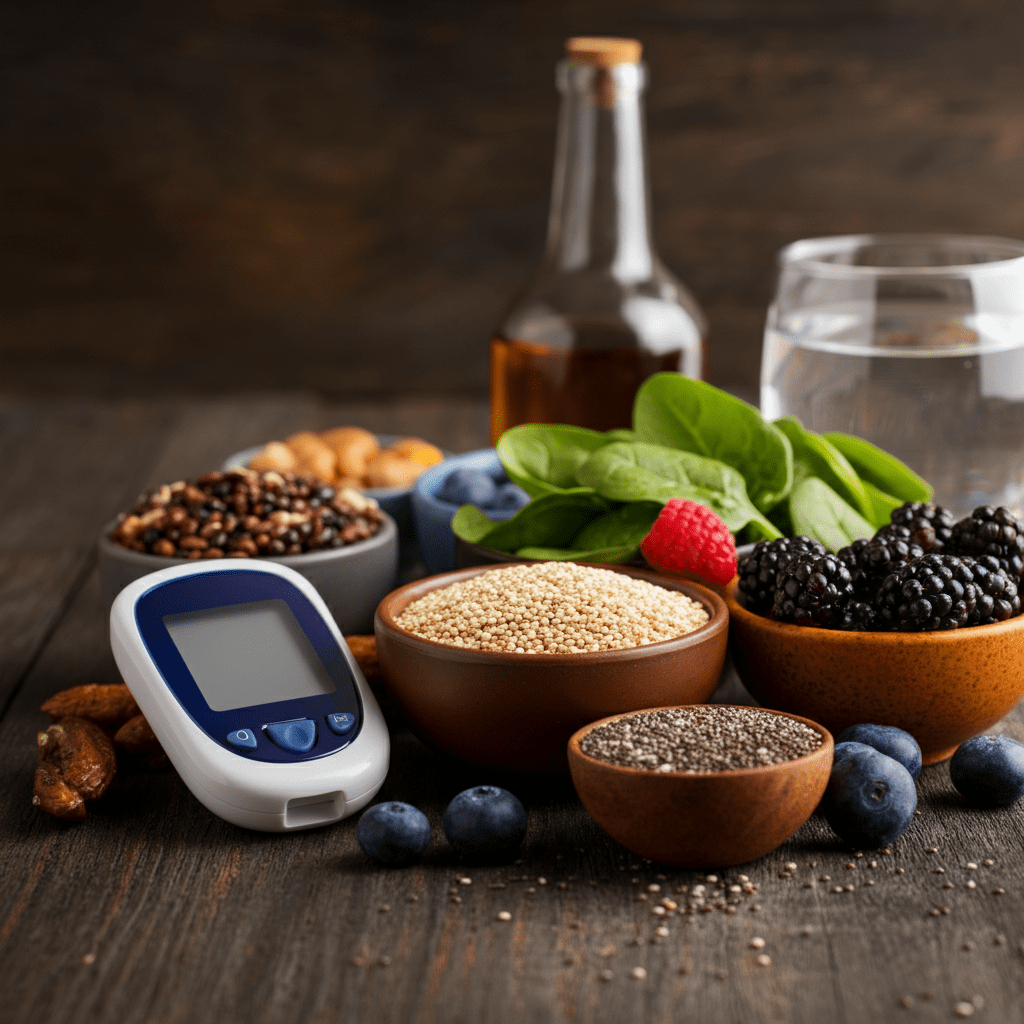
Table of Contents
It is natural to cope with diabetes using the proper approach. You want to reverse prediabetes, or just have better control of your blood sugar levels, and the approach is all-important. Putting emphasis on low-glycemic food matter, learning how to control the portion size, and learning about glucose-monitoring savvy can be all it takes. Also, some herbal sources of remedies, such as apple cider vinegar, cinnamon, and berberine, are demonstrating potential in promoting normal blood sugar levels.
This ultimate guide gives you the secrets step by step on how to deal with diabetes, including how to come up with a 30-day diet plan, the best fruits to consume by diabetic people, and how to make your own sugar-free dessert. And we will also discuss the support of intermittent fasting on the insulin resistance, and we will also talk about snacks that are friendly to diabetes. Are you ready to take the reins of your health to a proactive mode using natural, research-based approaches? Then continue reading.
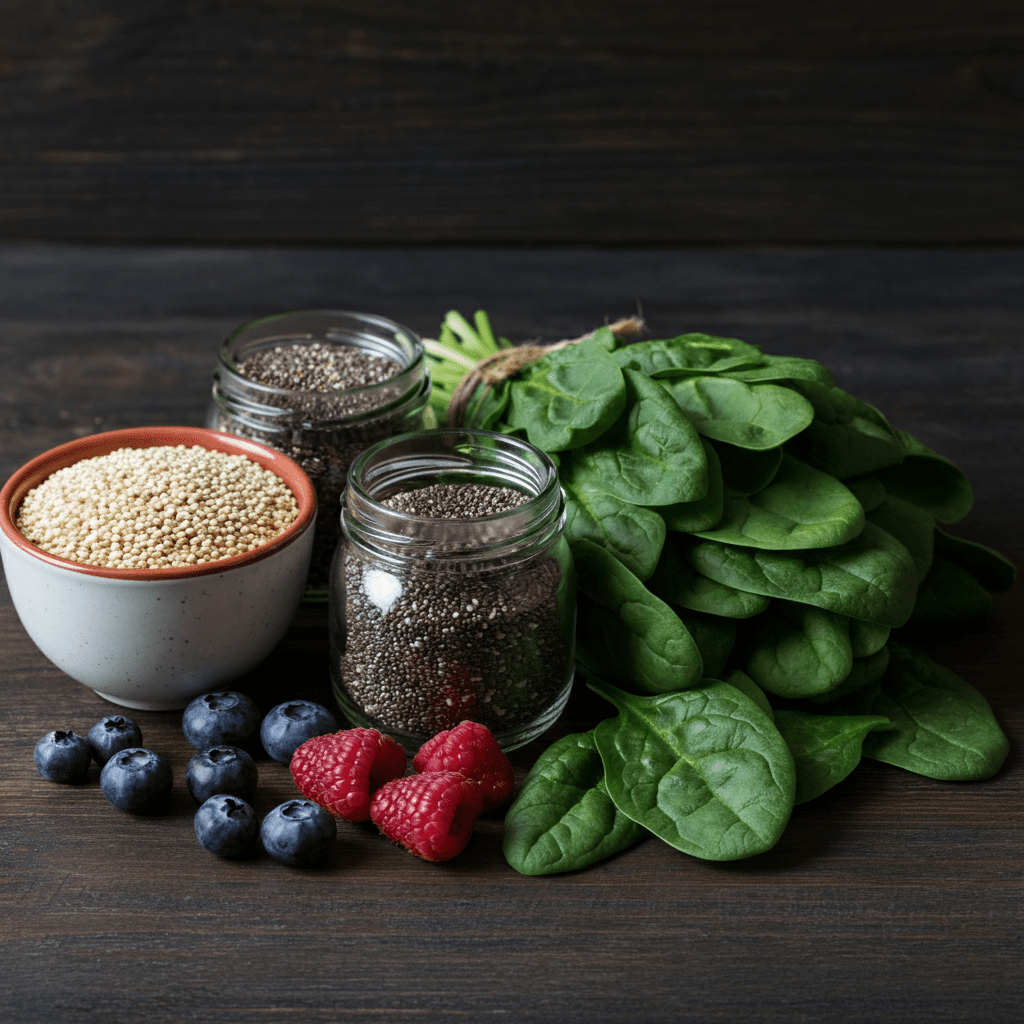
The Role of Low-Glycemic Foods in Blood Sugar Control
What Are Low-Glycemic Foods?
Low-glycemic foods are those that cause a gradual rise in blood sugar, rather than sudden spikes. They are essential for diabetics, because they help maintain stable glucose levels throughout the day.
Top Low-Glycemic Foods to Include
- Quinoa: A high-protein grain with a glycemic index of 53, perfect as a rice alternative.
- Chia Seeds: Packed with fiber, they slow digestion and prevent sugar surges.
- Leafy Greens: Spinach and kale are extremely low on the glycemic index and nutrient-rich.
Add these foods to your meals to provide sustained energy and better regulate blood sugar.
Portion Control Tips for Diabetes Management
The importance of Portion Size
Most foods that contain natural sugars are healthy, but they can make blood sugar level rocket in case of their abuse. Exercises on portion control will help control the number of calories and prevent overeating.
Real Life Portion Control Strategies
Use less plates: Use less plates, because with one it looks like so much more.
Pre-Portion snacks: Divide stuff like nuts, seeds and crackers into individual servings.
Plate Method Rule: Make half your plate veg, a quarter protein and a quarter carbs.
These are just some habits that can enable you to keep your glucose levels constant, without risking getting an extra unwanted weight.
Glucose-Monitoring Hacks and Tools
Monitoring glucose levels is a vital part of diabetes management. Here’s how to streamline the process.
- Use Continuous Glucose Monitors (CGMs): Devices like Freestyle Libre provide real-time data to track trends and refine your diet.
- Test Post-Meal Blood Sugar: Check your glucose two hours after eating to understand how certain foods affect you.
- Log Your Glucose Levels: Use apps to chart fluctuations and identify patterns.
These tools and hacks empower you to take a more proactive role in managing your diabetes.

Natural Remedies for Diabetes
A number of natural solutions may assist in humoring blood sugar:
- Apple Cider vinegar (ACV)
One or 2 tablespoons of water mixed and taken before meals reduces the post-prandial spikes in blood sugar because it slows down digestion and increases insulin sensitivity. - Cinnamon
Studies indicate that cinnamon reduces the concentration of sugar in the blood when fasting. Try to take 1 teaspoon each day sprinkled over oats or in a cup of tea. - Berberine
Having strong properties, berberine can fight insulin resistance and decrease A1C levels. Supplements should always be added in consultation with a health professional.
These home based remedies can easily be integrated in a diabetes lifestyle.

Your 30-Day Meal Plan for Diabetes
A regular food schedule makes it easy to cope with diabetes.
The general outline to follow is given below:
Week 1 Breakfast: Egg with unsweetened almond milk and chia seeds pudding.
Lunch: Warm salad quinoa with grilled chicken and spinach.
Dinner: Salmon baked and roasted vegetables.
Week 2 Breakfast:
Avocado and scrambled eggs, and a piece of whole-grain toast.
Lunch: soup of lentils with the accompaniment of a mix of greens.
Dinner: Stuffed bell pepper with turkey. Review again with minor changes in Weeks 3 and 4. Pay attention to balance and natural unprocessed food.
Sugar-Free Dessert Recipes
Managing diabetes doesn’t mean giving up desserts entirely. Here are two delicious, sugar-free options:
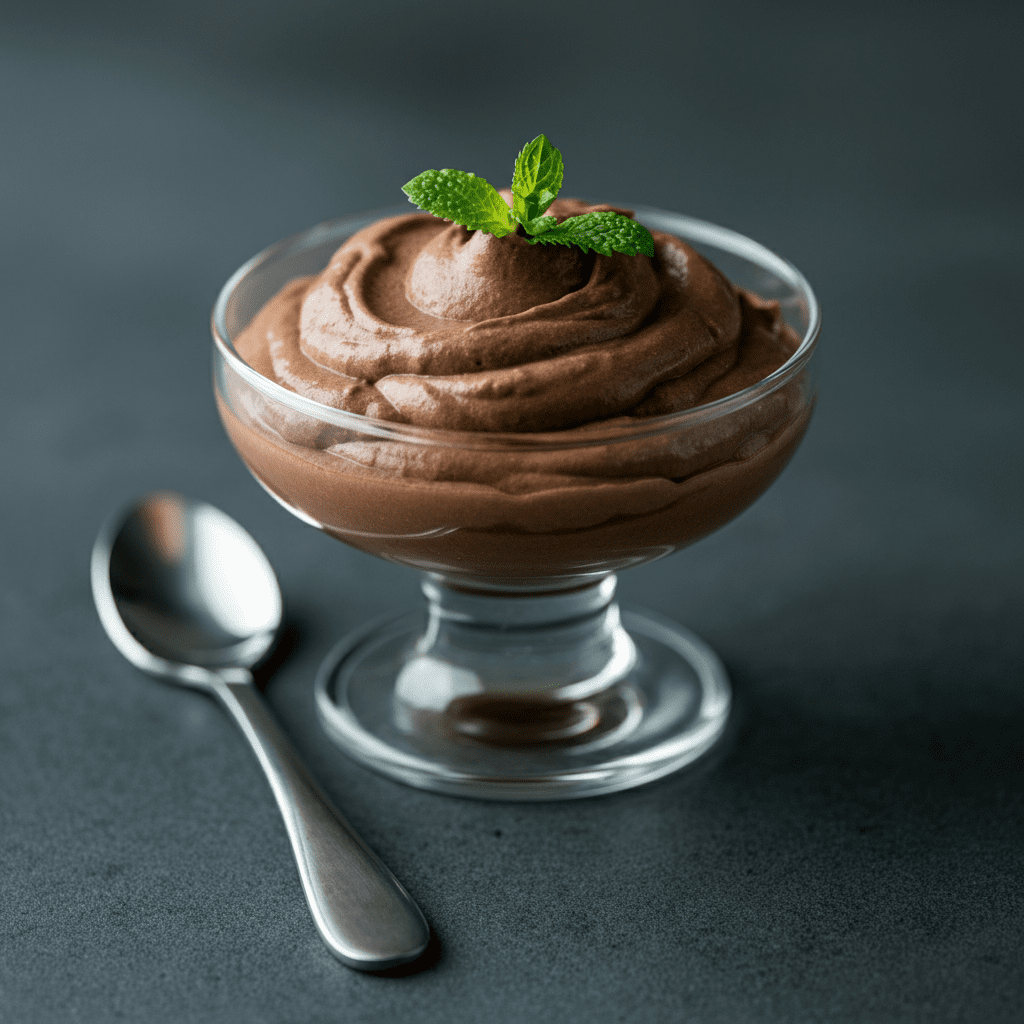
Sugar-Free Chocolate Avocado Mousse
- Blend ripe avocado, unsweetened cocoa powder, almond milk, and a natural sweetener like stevia for a creamy treat.
Greek Yogurt Berry Parfait
- Layer unsweetened Greek yogurt, fresh berries, and crushed nuts or seeds for a satisfying dessert option.
These recipes make it easier to enjoy sweets without impacting your blood sugar.
Best Fruits for Diabetics
Not all fruits are created equal when it comes to diabetes. Here are the top choices:
- Berries: Low in sugar but high in fiber and antioxidants.
- Apples: A great source of fiber to slow digestion.
- Citrus Fruits: Oranges and grapefruits pack vitamin C without spiking glucose.
Stick to fresh, whole fruits and monitor portion sizes for best results.
Intermittent Fasting for Insulin Resistance
The so-called interruption of fasting (IF) limiting food to a period of 8 hours can enhance insulin sensitivity. A study established that it facilitates more efficient use of glucose in the body and leads to weight loss, which is a major consideration in treating diabetes.
How to Start Intermittent Fasting
Start with one of the most basic techniques 16/8, which involves fasting 16 hours at night and eating during the other 8 hours of the day. Combine fasting and balanced meals. Do not overeat during the eating window, and eat healthy and wholesome food items to provide nourishment to the body.
Diabetes-Friendly Snack Ideas
Snack wisely to avoid blood sugar crashes. Here are some ideas:
- Greek yogurt with a handful of nuts.
- Baby carrots with hummus.
- A boiled egg with a piece of cheese.
These snacks are convenient, nutritious, and low on carbohydrates.
Importance of Staying Hydrated
Fluid intake is crucial in controlling diabetes and health in general. Information has indicated that the level of blood sugar and the normal operations of the body are maintained by drinking the required quantity of water. Try to consume as much water as possible (at least 8-10 glasses per day), and it can be flavored with a lemon or a cucumber slice. Avoid sweetened beverages and switch to unsweetened drinks, such as herbal teas or flavored water instead to diversify your choice. Drinking enough water may be an additional solution to hunger pangs and help manage appetite.
Simple Meal Planning Tips
Preplanning meals is one of the things that may help a lot with diabetes. First, aim at eating whole, unrefined foods, such as vegetables, lean meat and whole grains. Prepare a menu one week in advance that adds a good mix of nutrients to it. Do not make decisions regarding food super late, as the preprepared food will be much healthier than the one you chose to buy. You can use portion control devices or a small plate so that you eat the correct amount and include a lot of non-starchy vegetables. It takes little effort to make it so that healthy eating will become a natural process.
People also Ask (PAA)
- Which foods actually reduce A1C?
A1C can be lowered with time by consuming low-glycemic foods, such as quinoa, lentils, leafy greens, etc. Couple them with frequent physical activities to make the most out of them. - What is the relationship between apple cider vinegar and blood sugar?
Vinegar Apples cider vinegar has the ability to reduce post-meal glucose by increasing insulin sensitivity and reducing the rate of digesting carbs. - Does cinnamon help in curing diabetes?
When a person takes cinnamon consistently, studies indicate its ability to lower the fasting blood sugar levels when an individual has diabetes. - Can diabetics do intermittent fasting?
Sure, yet you need to check with some healthcare provider before resolving to fast intermittently so as to ensure it will fit within your health-related requirements. - What are the top snacks to use with type 2 diabetes?
Nuts, low-fat cheese, boiled eggs, and fresh vegetable with hummus are the examples of foods that fit in the diet of a person with diabetes. - Will berberine substitute diabetes medicine?
Berberine can only supplement other remedies and not substitute medicine without the consent of the medic.
Conclusion
It is inherent that diabetes treatment can only involve intelligent eating habits, control of meals consumption, natural products, and glucose regulation. Introducing low-glycemic food, trying tools such as CGMs, and having a meal plan may make all the difference. Support your efforts with natural remedies, such as apple cider vinegar and cinnamon, and with eating rhythms, such as intermittent fasting.
Never take large steps in changing the way you manage your diabetes without discussing with a healthcare professional. The body environment of one person is different and what might be effective with one person may not be good to the other. Also, a healthy lifestyle involving sedentary physical activity is a major aspect of controlling blood sugar. Walking, yoga, or strength training are activities that can create insulin sensitivity and well-being in general. Use of these natural programs together with professional help can help you get a good way of dealing with diabetes and still staying balanced in life.
Transform the way you handle diabetes now by adopting these suggestions. Small changes are sustainable and therefore the first step to better health!
M. Saim Akhtar
Certified Health Content Specialist at HealthBoostMax. INFS-qualified nutrition researcher with 5+ years of evidence-based health writing. Focus areas: health wellness information, preventive medicine, nutritional biochemistry, and fitness science. Content is for informational purposes only!
Men’s & Women’s Health
How to Balance Hormones Naturally for Women | Ultimate Hormone Balance Guide (2025)

Table of Contents
Hormonal balance is vital towards the overall well-being of the female, in that it has an impact on the energy level, mood, general skin and even the weight of the female. When the hormones, including testosterone, estrogen, cortisol and thyroid hormones, get out of the rhythm, it seems that everyday life is an uphill game. Other conditions that usually accompany this disproportion and may have powerful effects on your physical and emotional well-being are elevated levels of estrogens, adrenal burnout, as well as thyroid thyroid diseases.
Fortunately, there are certain natural solutions that will help you adjust the hormonal balance of your body. Pour in some hormone-friendly food options, some real-life inspired lifestyle shifts and the power of herbs and supplements, and you will get in positive control of your hormone balance. This book is a no-nonsense, evidence-based guide to ensure that you can take the lead in regulating your own hormonal happiness and feel fine.
Top Foods for Hormone Balance
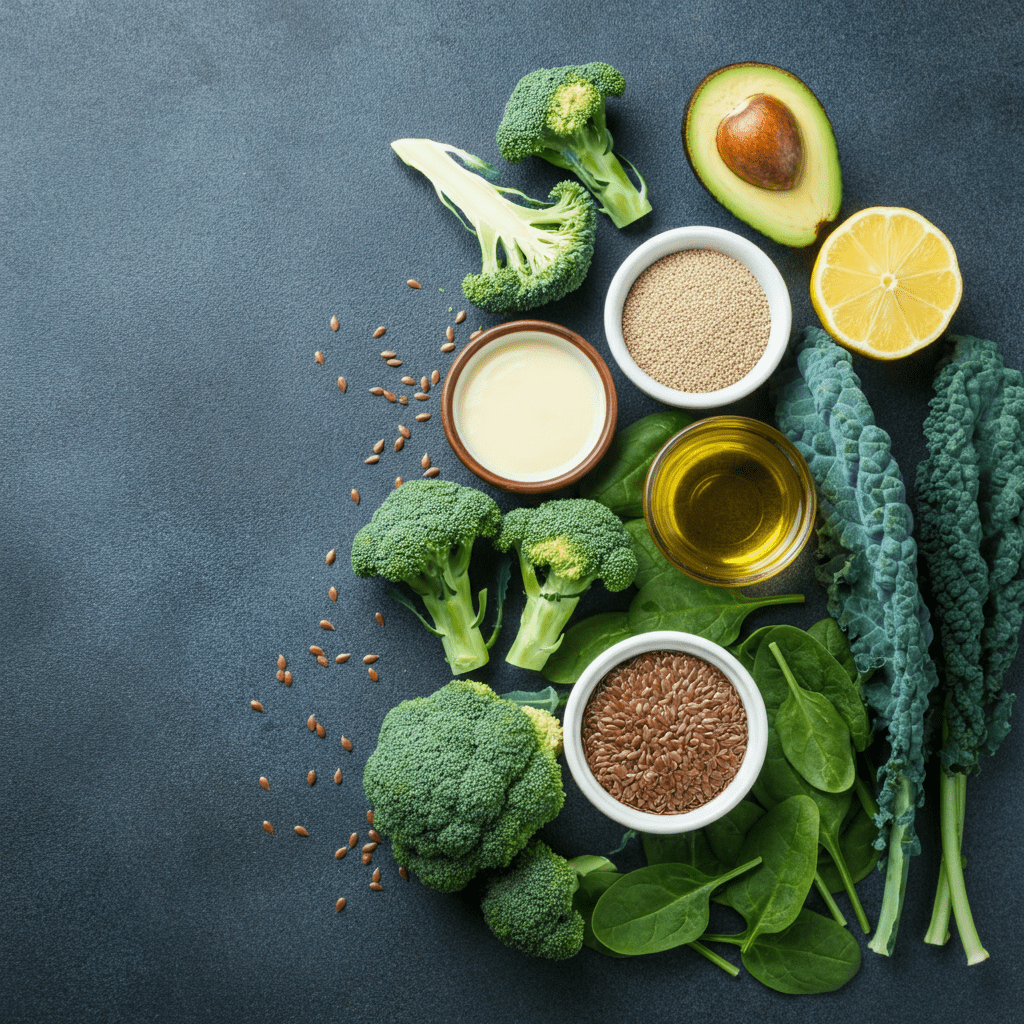
- Cruciferous Vegetables
Cruciferous foods (e.g. broccoli, cauliflower, kale, brussel sprouts) carry such mighty compounds as indole-3-carbinol (I3C). This nutrient aids the detoxification of the liver, and your body can clear up the extraneous estrogen. Adding these vegetables regularly to the diet can reduce estrogen dominance and restore hormonal balance. - Flaxseeds
Flaxseeds are also an excellent source of the lignans, compounds that simulate estrogen in the body and ratify the hormonal swings. They also contain good levels of omega-3 fatty acids that also help in the reduction of inflammation, benefiting the health of the endocrine system. Add finely crushed flaxseeds to oatmeal or supplement smoothies. - Healthy Fats
Hormones are made with the help of fats. Olive oil, fish, avocado and other sources containing omega 3s and monounsaturated fats ensure the adrenal glands are nourished, and levels of cortisol are lowered. Good fats promote healthy brainwork, stabilization of moods, and skin. - Fermented Foods
What is related to hormone functioning is your gut. Healthier microbiome through foods that offer probiotics, such as yogurt, kimchi, and sauerkraut, contribute to the production and balancing of such hormones as serotonin and insulin. - Vitamin-Rich Fruits
Berries, citruses, pomegranates are fruit varieties which contain large amounts of antioxidants and necessary vitamins, such as Vitamin C. These nutrients fight against oxidative damage, inflammation, and improve the overall endocrine wellness.
Lifestyle Changes for Hormone Health
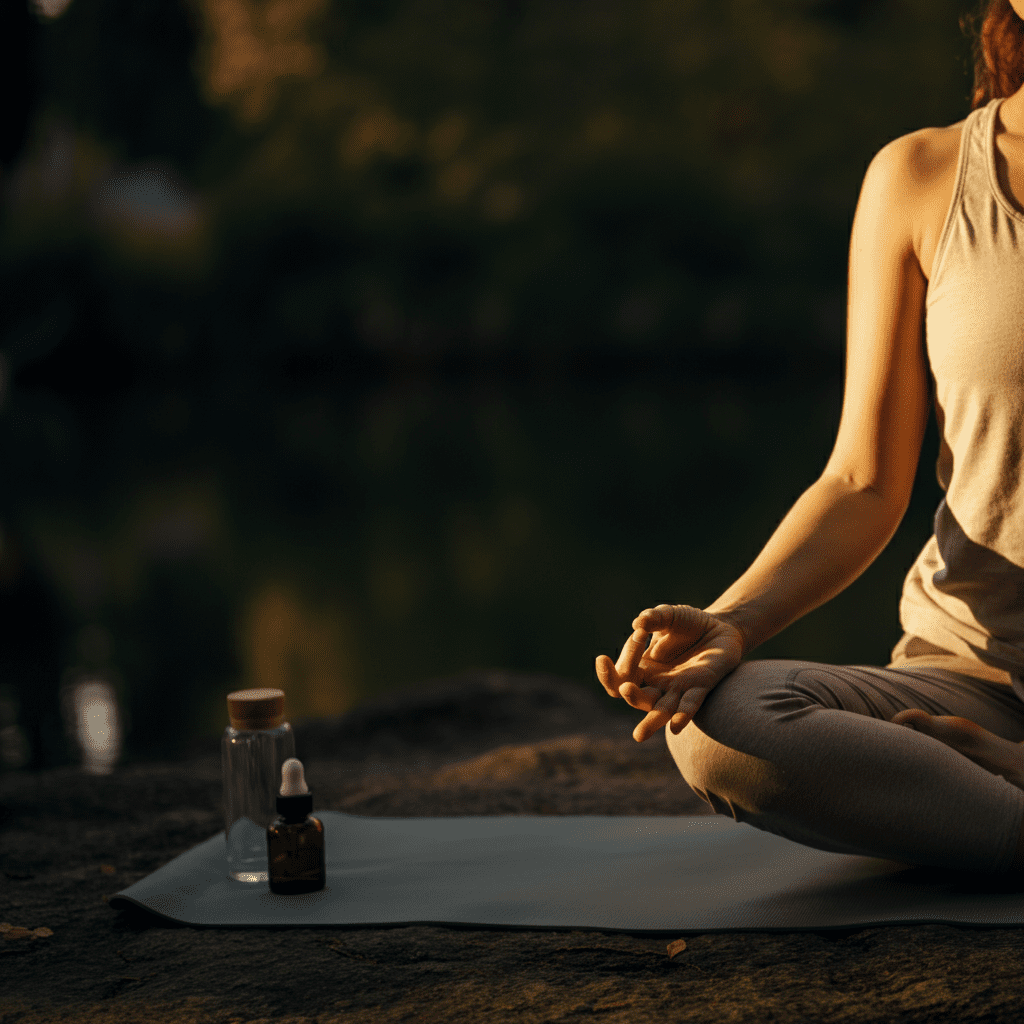
Prioritize Sleep
Sleep is the keystone of controlling the hormones. The insufficient amount of sleep influences the secretion of the cortisol, which promotes the enhancement of the stresses and obstructs the normal functioning of the other hormones. You have to attempt to have a good 7-9 hours of sleep at night and create a routine bedtime that would preserve your circadian clock.
-Aim for 7-9 hours of quality sleep per night.
-Benefits: Proper rest is essential for cortisol regulation and hormonal production.
How to Deal with Stress
The drawn out pressure forces the cortisol crisis to reach high limits, causing a distraction in the entire course of the endocrine organs. Such simple things as deep-breathing exercises, meditation and yoga can promote emotional health and reduce cortisol production. Even shy 10 minutes of mindfulness a day help.
- -Techniques: Yoga, meditation, or deep breathing exercises. -Benefits: Reducing stress levels can lower cortisol, helping to create a balanced hormonal environment.
Take It With Your Period
Knowing your menstrual cycle can help you form a balance in your activity, nutrition and self-care according to your body rhythms. As an example, emphasis on nutrient rich foods and low energy expenditure during the luteal phase where energy is low and elevated physical activity during the follicular phase where energy is high.
Stay Active Without Overtraining
Regular moderate exercises help regulate insulin, support to the thyroid, and reduce estrogen dominance. However, excessive intensive exercises can result in excess cortisol. Get together with strength exercise, aerobics and recovery activities (like yoga) and do your hormones a favor.
Herbs & Supplements

- Ashwagandha
Ashwagandha is an adaptational supplement that controls the cortisol levels and slows down the stress and fatigue levels. It also helps in the health of the adrenals which is important in hormonal balance. It is available in capsule or tea. - Maca Root
The Maca root is described to increase energy, aid procreation, and hormonal reproductive equilibrium. It is especially useful at perimenopause and menopause when the market level is not stable. One can mix the maca powder in a glass of smoothie or in some tea to reap the benefits. - Vitex (Chaste Tree Berry)
A herbal therapy known as vitex is a common medication in PMS symptoms relief and increasing progesterone. It operates through its effect on the pituitary gland to regulate menstrual periods and synthesis of hormones. - Evening primrose oil
Evening primrose oil is rich in gamma linolenic acid (GLA) and relieves the typical symptoms associated with estrogen imbalance, such as tender breasts and mood swings. - Magnesium
Magnesium is significant in more than 300 enzyme reactions including the hormonal processes. It is useful in battling stress, enhancing sleep, as well as blood sugar control. Try vitamins or foods such as spinach, almonds, and black beans since they are magnesium-rich foods. - Supplements
- Omega-3 Fatty Acids:
- Sources: Fish oil or algae supplements.
- Benefits: Help manage inflammation and support hormonal balance.
- Vitamin D:
- Benefits: Essential for hormone production and immune support.
Signs of Hormones Imbalance
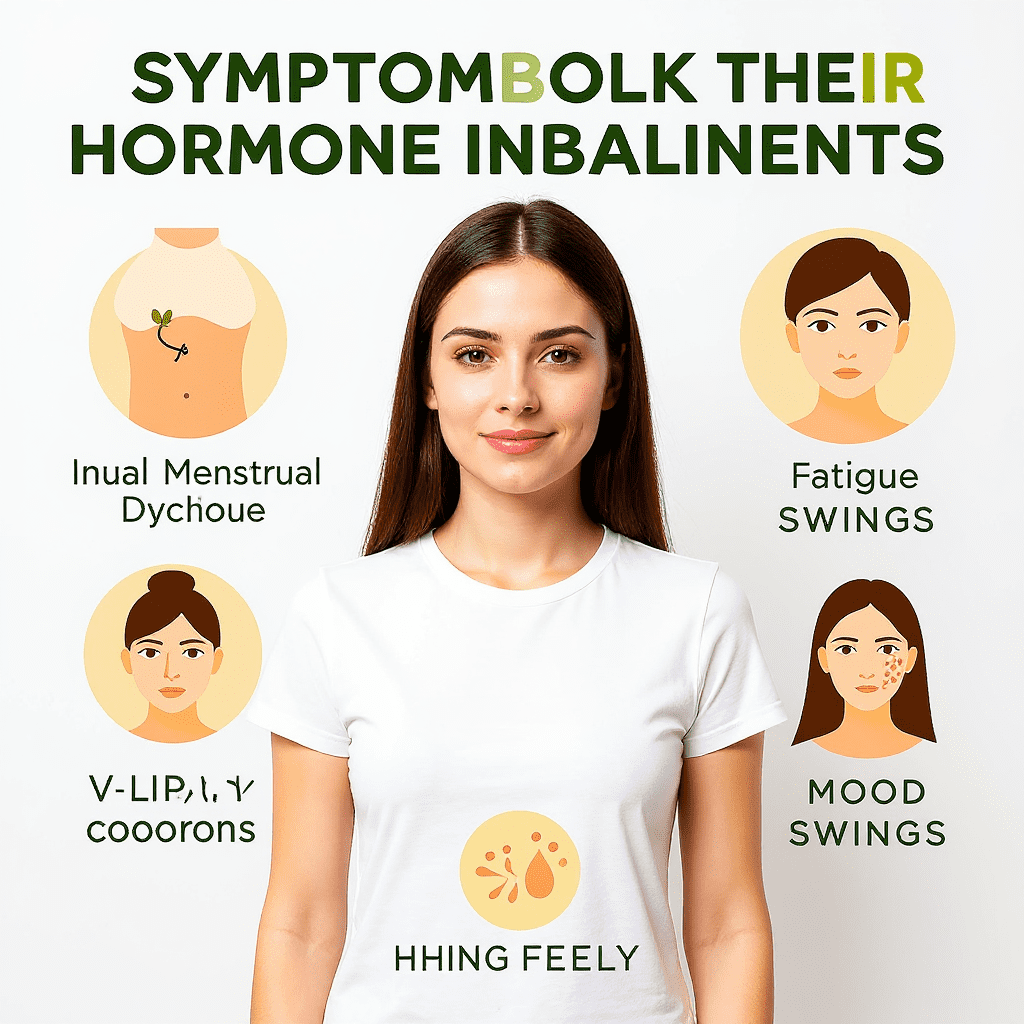
- Irregular Menstrual Cycles
Frequent, infrequent, or missed periods may point to issues like PCOS or thyroid dysfunction.
- Fatigue
Persistent low energy could indicate cortisol dysregulation or an underperforming thyroid.
- Weight Gain or Loss
Unexplained changes in weight could signal insulin resistance or problems related to cortisol.
- Mood Swings
Frequent emotional highs and lows may point to estrogen or progesterone imbalances.
- Skin Problems
Acne, dryness, or excessive oiliness can often be traced back to hormonal inconsistencies.
How to Track Progress

1. Keep a Symptom Journal
Document changes in mood, sleep patterns, energy levels, and physical symptoms daily. Over time, this can reveal patterns and track improvements as you adjust your lifestyle.
2. Lab Testing
Regular bloodwork or saliva tests can provide insights into your hormone levels. Focus on estrogen, progesterone, testosterone, cortisol, and thyroid hormone levels to get a full picture of your endocrine health.
3. Use Technology
Apps designed for menstrual and hormonal tracking can simplify the process. Many tools offer reminders and insights into your cycle phases, helping you align activities with your natural rhythms.
4. Work with a Specialist
Partnering with an endocrinologist or holistic health practitioner can ensure you receive personalized guidance based on your specific hormone needs.
FAQs
- What foods regulate hormones in women?
Hormone-regulating foods include cruciferous vegetables, flaxseeds, fatty fish, and fermented foods.
- What are symptoms of hormonal imbalance in women?
Common symptoms include irregular periods, fatigue, mood swings, and unexplained weight changes.
- How does stress affect hormones?
Stress elevates cortisol, which can disrupt adrenal function and imbalance other hormones like estrogen and testosterone.
- How can I balance my hormones during perimenopause?
Focus on consuming phytoestrogen-rich foods (like flaxseeds), managing stress, and incorporating adaptogenic herbs such as maca root or ashwagandha.
- Can lack of sleep cause hormonal imbalance?
Yes, inadequate sleep disrupts cortisol and melatonin rhythms, negatively influencing thyroid and reproductive hormones.
Summary
Natural balancing of your hormones requires a complex approach, which can be achieved through herbs and supplements, specially sourced nutrition as well as a mindful change in lifestyle. Sleeping, getting rid of stress, consuming hormone-nurturing foods and being conscious of your body messages is a good way to give yourself power to rein back control of your health. Take it one step at a time, and today make one or two changes in your routine, and record some progress somewhere so as to mark incremental changes in a celebratory fashion.
Be in control of your health now- the healthier and happier you is attainable. When you are ready to have more detailed recommendations, it is high time you refer to a health care expert to develop a personal hormone-balancing program.
M. Saim Akhtar
Certified Health Content Specialist at HealthBoostMax. INFS-qualified nutrition researcher with 5+ years of evidence-based health writing. Focus areas: health wellness information, preventive medicine, nutritional biochemistry, and fitness science. Content is for informational purposes only!
Disease Prevention & Health Tips
COVID Vaccine Heart Risk Warnings and Safety Update in 20025

Table of Contents
The current struggle to contain the COVID-19 pandemic has led to the achievement of great accomplishments in most areas, especially in the development of vaccines. Whereas the efficacy of COVID -19 vaccines in the reduction of severe illness and saving human lives across the globe has come to form, recent reports have partly shown that the possible cardiac risks are there. The article explores the recent evidence, governmental health warnings, and advice of specialists regarding potential heart-related side effects caused by COVID-19 vaccines, as it includes the information needed by the readers to make beneficial decisions regarding their wellbeing.
In this article, we dive into the latest updates on heart-related risks from COVID vaccines. We’ll discuss the research, the official warnings, and most importantly, how these insights impact your safety. Understanding these risks is crucial not only for those considering the vaccine but also for those who have already been vaccinated.

Understanding the Context of COVID Vaccinations
What Makes COVID Vaccines Essential?
Vaccines against COVID-19 form an important instrument in regulating the pandemic in the world. They have succeeded in curbing the rate of hospitalization, severe disease, and avoided virus transmit risk. The One example of the world can be seen in the process of vaccination around the globe and helping millions of individuals survive.
The Role of Vaccines in Public Health Safety
Vaccines such as Pfizer-BioNTech mRNA-based and Moderna helped create new solutions to the combat of a mutating virus. Nevertheless, since vaccines were distributed to billions of people around the world, post-marketing surveillance was able to report a rare number of side effects and continue to investigate their transparency and safety.
Heart Risks and COVID-19 Vaccines
As more people focus on the safety of vaccines, researchers have raised concerns about some cardiac adverse effects of the vaccines, such as myocarditis and pericarditis, mostly among the younger population. Although such cases are rare compared to the great advantages that vaccines bring, it is critical to realize the dangers.
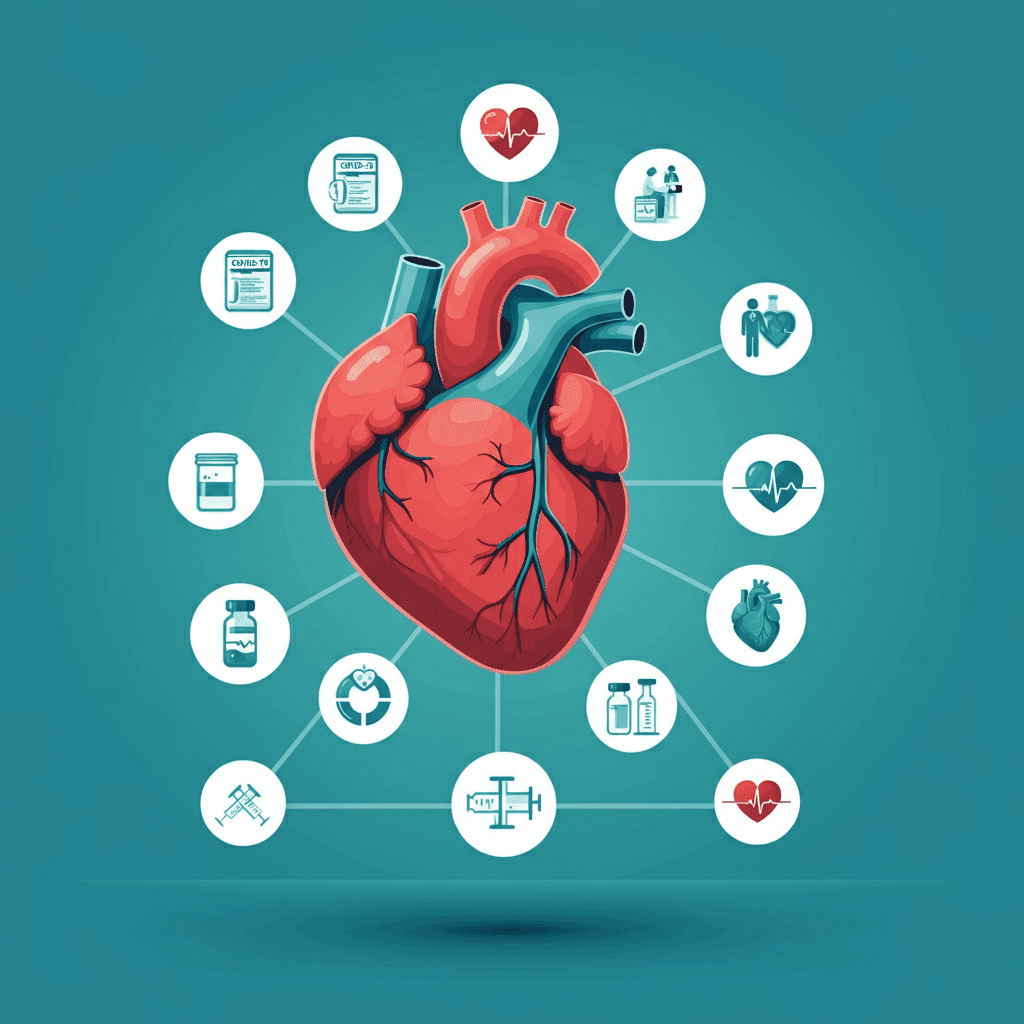
Myocarditis and Pericarditis Explained
Myocarditis is inflammatory disease of the heart muscle, which may impair the normal pumping activity. However, pericarditis is a condition that is related to inflammation of the lining on the heart. Chest pains characterize it, heart palpitations and breathlessness.
Who is Most at Risk?
According to epidemiological data, myocarditis and pericarditis are specifically frequent among young men (systematically aged 1230) after mRNA-based vaccines against COVID-19. These cases, however, are mostly mild and respond to treatment.
Recent Studies on COVID Vaccine Heart Risks
Recent studies in the renowned medical periodicals have shed considerable light on vaccine-induced cardiac inflammation:
- Occurrence and Severity: Among millions vaccinated, myocarditis affects around 12 cases per million doses but shows mild intensity in most incidents.
- Comparison with COVID Illness Risks: COVID-19 itself poses significantly higher cardiac risks than vaccination, including severe myocarditis in multiple age groups.
Emerging data underlines the need for balanced risk assessment, emphasizing that vaccination remains a safer alternative than contracting the virus.
Global Health Warnings and Updates
Warnings From Medical Authorities
Rare risks of heart concerns associated with the vaccine have been monitored and reported by health organizations around the world, such as CDC and WHO:

The United States Centers for Disease Control and Prevention (CDC) also confirmed myocarditis, but then repeated that the benefits of vaccines are enormous.
On a similar note, the World Health Organization (WHO) has underscored that the benefits are much higher than risks, especially in the prevention of COVID-19 complications such as the long-term lung damages or heart diseases.
Updated Vaccine Safety Guidelines
Depending on the findings of the surveillance, the regulatory authorities have proposed the following measures to improve the safety of the vaccines:
Age Specificity: Place visible emphasis on monitoring younger populations to track down the occasional risks more timely.
Transparency of Information: Sharing elaborate risked based profiles with other healthcare experts and the population.
Optimized dosages of vaccines: This may be looking into the possibility of lower doses in the young population to achieve efficacy and reduced side effects.
Solutions to Address Heart Risks
1. Identifying Signs in Early Stages:
Be vigilant of the signs of myocarditis or pericarditis after vaccination such as chest pain or shortness of breath.
2. Routine Health check ups:
In case you belong to a risk group, make health checkups regularly, and it will be possible to notice complications in time.
3. Staying Informed:
There are sufficient sources where one can get reliable information about health issues including FDA and local health agencies. Be informed of current news of vaccine safety according to your region.
Balancing Risks and Benefits
It is vital that we put vaccine-associated dangers into a bigger picture. Health professionals always indicate that the risks of infection are much greater than the slight side effects of vaccine reported.
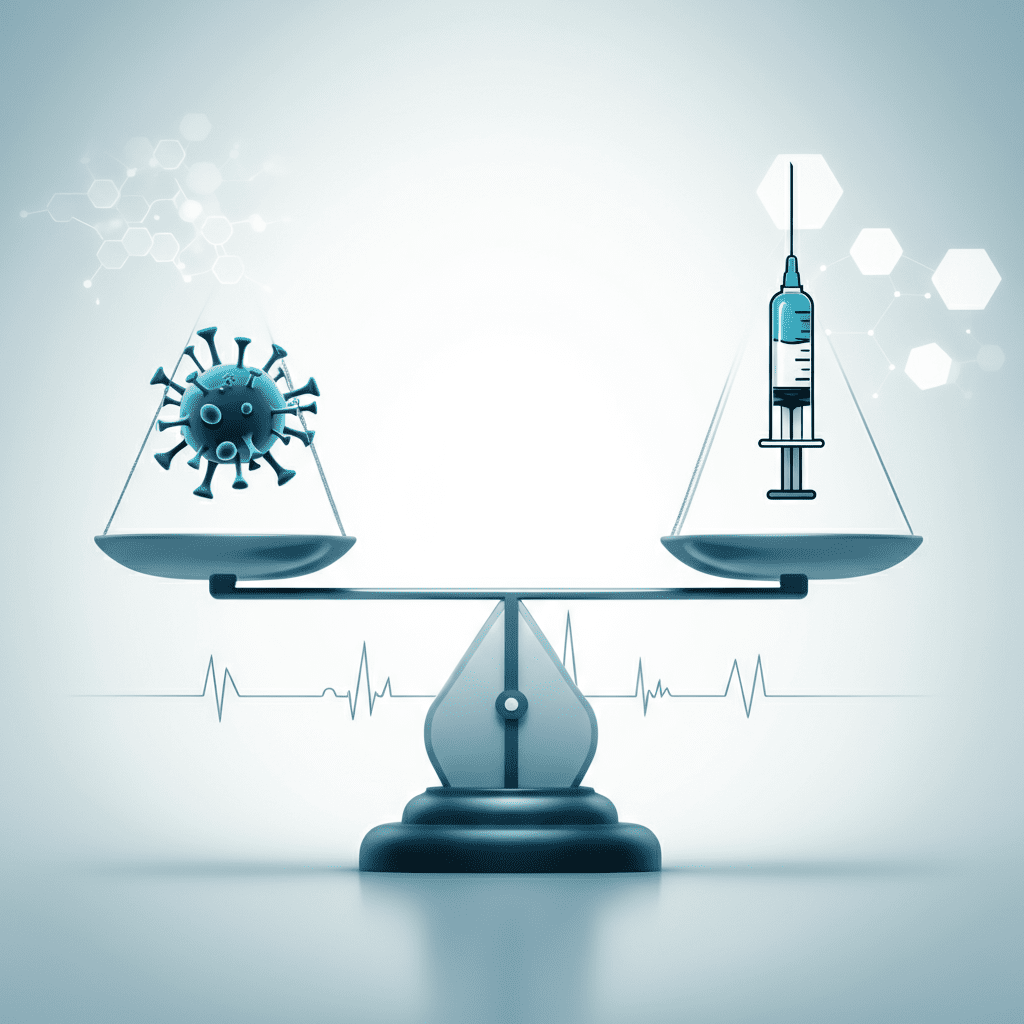
Why Getting Vaccinated Still Matters
The COVID-19 has endangered world health not only due to the immediate effects of the disease, but also because of possible permanent consequences on the heart and other important body systems. Vaccines are part of the puzzle to reduce these risks and immunize whole populations, particularly vulnerable populations, e.g. seniors or those with preexisting conditions.
Addressing Public Concerns Through Honest Communication
With the issue of anxiety, public health agencies have tried to work on them by giving transparent reporting and then adapting their recommendations. The measures instill the confidence of the citizens as they develop safer vaccination drives to all.
People Also Ask (PAA)
- 1. Are portable monitors a good purchase?
Of course, make a buy of portable monitors on the condition that you have a requirement to have additional screen space to multitask, game, or work on the go. Pre-owned models come down to under 100 dollars. - 2. Is a portable monitor compatible with any laptop?
Majority of portable monitors can be connected to a laptop through USB-C, HDMI or USB 3.0. Make sure that your laptop possesses the necessary ports. - 3. What powers the portable screens?
USB powered Portable monitors tend to be portable and cost less than a hundred dollars. These monitors mean that they are powered with the same cable that links them to your laptop. - 4. Which things should I consider when choosing a cheap portable monitor?
Seek compatibility, resolution, weight and usability. Make sure that the monitor would support your working process or your leisure activities. - 5. Are drivers required to go with portable monitors?
Most of the current portable monitors are plug-and-play and do not needs extra drivers; however compatibility with your operating system.
Conclusion
The potential of vaccines as a risky phenomenon should be approached with a delicate touch informed by reliable analyses and opinions of specialists. Although warnings about heart issues are justified, they cannot be discussed as a sufficient evidence against vaccination as the undoubted advantages of this procedure against severe results of COVID-19 are too strong.
Global vaccination can continue to work effectively through vigilance, open communication, and following the health protocols and protect communities and individuals alike.
The overall safety profile is excellent, and the risk of severe illness from COVID-19 far exceeds the risks associated with the vaccine. Staying informed and following health guidelines will help ensure that you make the best choice for your health and safety.
M. Saim Akhtar
Certified Health Content Specialist at HealthBoostMax. INFS-qualified nutrition researcher with 5+ years of evidence-based health writing. Focus areas: health wellness information, preventive medicine, nutritional biochemistry, and fitness science. Content is for informational purposes only!
-

 Healthy Lifestyle & Nutrition3 months ago
Healthy Lifestyle & Nutrition3 months agoBest Foods to Boost Testosterone Naturally in 2025
-

 Healthy Lifestyle & Nutrition3 months ago
Healthy Lifestyle & Nutrition3 months agoHow to Boost Your Immune System Naturally (2025)
-

 Healthy Lifestyle & Nutrition3 months ago
Healthy Lifestyle & Nutrition3 months agoTop Superfoods for Energy in 2025 – Boost Your Vitality
-

 Disease Prevention & Health Tips3 months ago
Disease Prevention & Health Tips3 months agoCOVID Vaccine Heart Risk Warnings and Safety Update in 20025
-

 Fitness & Exercise3 months ago
Fitness & Exercise3 months agoSimple Exercises to Boost Flexibility with Arthritis
-

 Fitness & Exercise2 months ago
Fitness & Exercise2 months agoHealthy Meal Plans for Men | 3,000-Calorie Muscle-Building Ultimate Guide
-

 Men’s & Women’s Health2 months ago
Men’s & Women’s Health2 months agoHow to Balance Hormones Naturally for Women | Ultimate Hormone Balance Guide (2025)
-

 Mental Health & Wellness3 months ago
Mental Health & Wellness3 months agoQuick Stress Relief Techniques for Instant Calm(2025)
-

 Fitness & Exercise3 months ago
Fitness & Exercise3 months agoCardio Exercises for Weight Loss at Home in 2025
-

 Healthy Lifestyle & Nutrition2 months ago
Healthy Lifestyle & Nutrition2 months agoHow to Detox Your Body Safely at Home in 2025


